
 |
Home | Contact |
Updated: October 2011. Click on an image to see the FULL size with a caption.
The following reference information is included:
My rating scale:
 Excellent ;
Excellent ;
 Very Good ;
Very Good ;
 Good ;
Good ;
 Fair ;
Fair ;
 Poor.
Poor.
My favourite K2 trekking guidebooks:
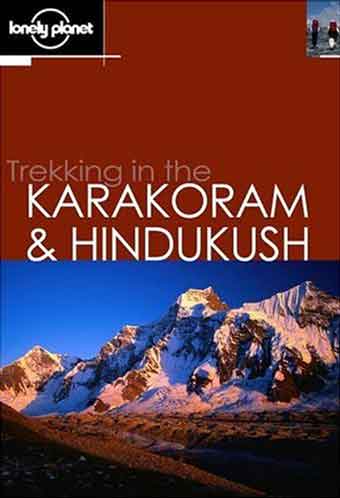
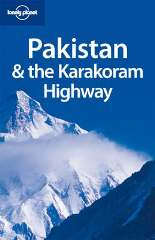

My favourite guidebook series - the right amount of detail, well written, accurate descriptions, great maps.

My favourite guidebook series - the right amount of detail, well written, accurate descriptions, great maps.
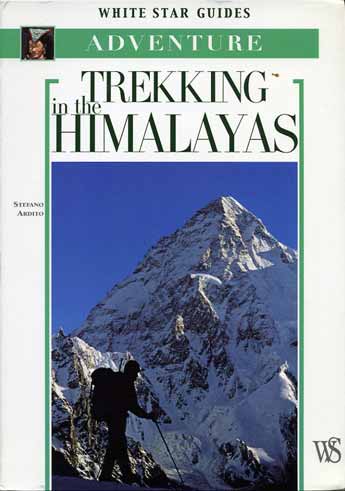
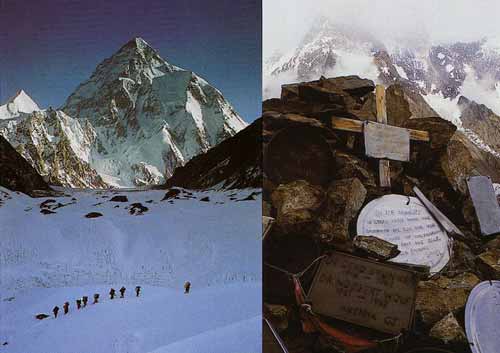

by Stefano Ardito. Published 2006. This trekking guidebook contains basic descriptions of 15 treks: Tirich Mir, Kafir Valleys, around Nanga Parbat, traversing the Biafo and Hispar Glaciers, K2, Zangskar, source of the Ganges, Kailash, Annapurna Sanctuary, around Annapurna, Mustang, Langtang and Helambu Valleys, Everest Nepal, Everest North ABC and Kangshung East Face, and Chomolhari. Each trek has an overview, useful information, a map and a day-by-day description. There are almost 250 photos. The cover is K2.
There are 14 pages on the Baltoro trek to K2, with views of Broad Peak and the Gasherbrums.
The maps and photos are very good.
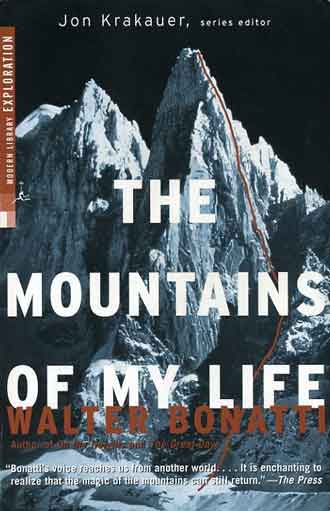
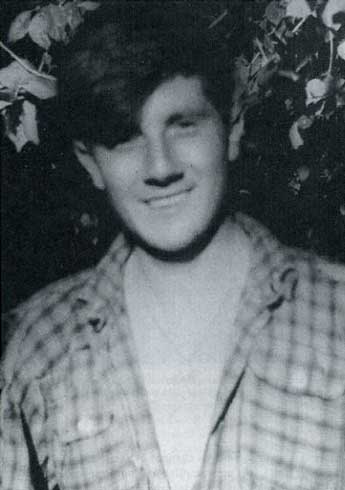
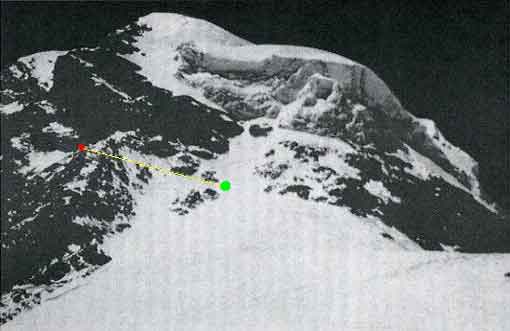
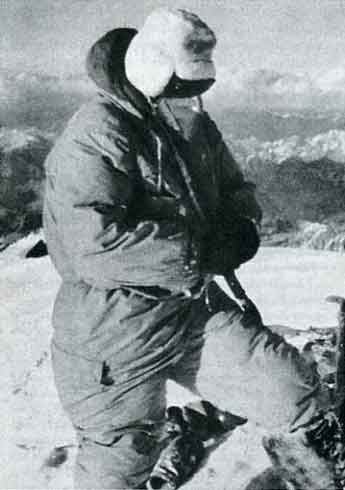

by Walter Bonatti, translated by Robert Marshall. This book collects the classic writings of world-famous mountaineer Walter Bonatti (many from On The Heights and The Great Days). The cover is Bonatti's solo route on the south-west pillar of the Petit Dru from August 17-22, 1955. The book has 26 pages of b/w photos, 3 b/w photos in-line with text, and 8 route maps.
The book starts with his climbs on Grande Jorasses, Grand Capucin and Lavaredo in winter. He was then invited on the 1954 Italian K2 expedition, where Lino Lacedelli and Achille Compagnoni became the first to summit K2. Controversy struck when the expedition leaders accused him of turning back before delivering needed oxygen to them below the summit. After staying quiet for 50 years, Lacedelli finally published his view of what happened, corroborating Bonatti's story.
Bonatti continued on to execute many great climbs, including a solo climb of a new route on the south-west pillar of the Aiguille du Dru, Cerro Torre, the first ascent of Gasherbrum IV, the North Face of the Grande Jorasses in winter, an unprecedented solo ascent of the north face of the Matterhorn in winter, and the tragic story of the death of four mountaineers from exhaustion attempting to be the first to climb the Central Pillar of Freney in June 1961.
About a quarter of the book is dedicated to K2 and the aftermath. There are 9 pages of b/w photos and 1 b/w photo in-line with text. Walter Bonatti and Mahdi carried the oxygen bottles to Camp IX on July 30, 1954. But Compagnoni had intentionally moved the camp from the planned site so Bonatti could not try for the summit. "'Lino! Achille! Where are you? Answer me!' Everything was silent." Eventually they responded. "'Have you got the oxygen?' the voice continued. '“Yes!' I replied. 'Good! Leave it there and go straight down!' 'I can’t' I protested. 'Mahdi couldn’t make it!' ... We waited in vain for Lacedelli and Compagnoni to reappear. We began to call again to ask for help, but no one answered us all night long." Bonatti and Mahdi survived the bivouac at 8100m, but Mahdi had frostbitten toes. This amazing event was only briefly mentioned in the official account by Desio.
In 1964 a reporter printed a 10th anniversary article finally bringing out into the open Desio and Compagnoni's views of what really happened. They accused Bonatti of treachery, trying for the summit and using the oxygen. Bonatti filed a libel suit, which was held in Turin in 1966. Mahdi’s deposition was confusing, with conflicting statements. Bonatti and Mahdi did not have the respirators, so they could not have used any oxygen. Bonatti was exonerated. Bonatti then does his own analysis and uses diagrams and charts to prove that the oxygen had not run out. In The Price Of Conquest from 2004, Lacedelli disagrees with Bonatti, saying that the oxygen had in fact run out.
Robert Marshall then does his own analysis, reviewing Mahdi’s story and figuring out how he could have been telling the truth. "Bonatti spoke neither English nor Urdu, and Mahdi no Italian. ... There seems no doubt that Desio genuinely believed that Bonatti was guilty. ... Mahdi was frostbitten and Bonatti was condemned, but the expedition would claim resounding success at all levels and the glory of Italy was intact. ... (Compagnoni) portrayed Bonatti as a devious and treacherous competitor for the summit, a cheat who used precious oxygen, a coward who gave none to Mahdi and then abandoned him to his fate, and a liar who then had the effrontery to pretend his loyalty to the team.
Marshall concludes quite convincingly: "The whole affair started because Mahdi thought he and Bonatti were making an independent attempt on the summit. ... Bonatti made a very convenient villain and an ideal sacrificial goat. He was never able to defend himself because he was never accused directly."
In 2008 the Club Alpino Italiano recognised officially that Bonatti's version of the ascent was correct. Compagnoni and Lacedelli reached the summit with oxygen after putting the life of Bonatti and the hunza Mahdi in serious risk by denying them help at 8100m while they carried the oxygen supplies to the last camp.
This is one of my top 10 favourite books of all time. The photos are good. The K2 story is far better than anything Hollywood could dream up. It has tremendous physical achievement, intrigue, back-stabbing, analysis, and finally exoneration. Bonatti packs his pages with a total punch, introspective, exciting, and dangerous. You can just about feel the bitter cold.
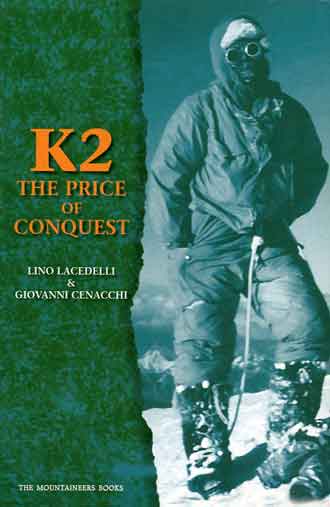
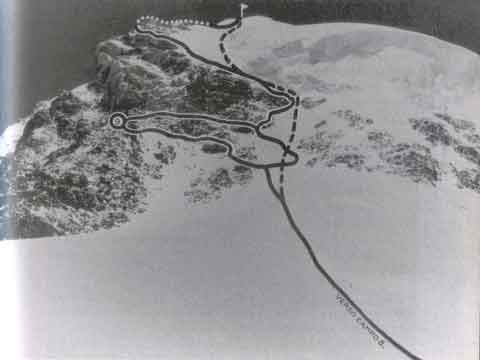
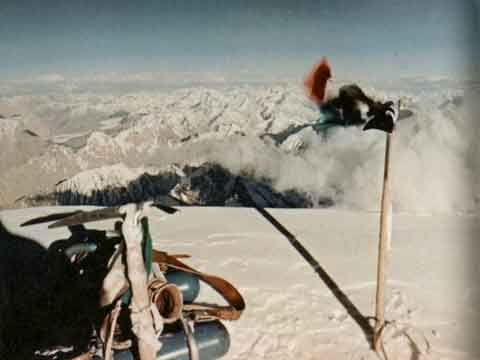

by Lino Lacedelli in interviews with Giovanni Cenacchi in 2003. Published in Italian in 2004. Published in English in 2006. After 50 years, Lacedelli finally talks about what really happened on the first ascent of K2 in 1954. He agrees that Walter Bonatti became a victim and a sacrificial lamb. The cover is Lino Lacedelli on K2 Summit. There are 16 pages of colour photos, 12 pages of b/w photos, and 27 b/w photos in-line with text.
Lacedelli doesn't mince word describing expedition leader Ardito Desio: "If Cassin had come, all the newspapers would have focused on him rather than Desio. ... Desio preferred those who agreed with him ... (Compagnoni) flattered Desio and vice versa. ... Desio carried on giving his daily orders, but for us it was like he didn’t exist. His orders were no good, they didn’t help us with our problems."
Lacedelli blames Achille Compagnoni for changing Camp IX to the left of the planned location: "I believe he didn’t want Bonatti to reach us. ... It was just the two of us that had to make the final climb to the summit. ... It was dark and the traverse was really difficult. So I shouted to Bonatti, ‘Don’t come up, it’s too dangerous. Go back to Camp VIII, leave the bottles where you are’."
Lacedelli confirms Bonatti’s timing that they probably reached the oxygen bottles left by Bonatti around 7:30 on the summit morning, and not at 5am as claimed in Desio's book. He disagrees with Bonatti that the oxygen did not run out: "The truth is that the oxygen ran out before the summit. ... So we decided to carry them to the top as a sort of proof that we had reached the summit. We also stayed roped together even though we didn’t need to any more."
"So we linked arms and I said, ‘Together’. … We were so pleased. On the summit the view was astounding. ... I have always spoken well of Bonatti. I have always said that, without his sacrifice, the two of us would not have reached the summit."
Lacedelli tells it like it is for the whole expedition from beginning to end. He finally clears up the disputes between Bonatti and Compagnoni and Desio. The photos are very good.
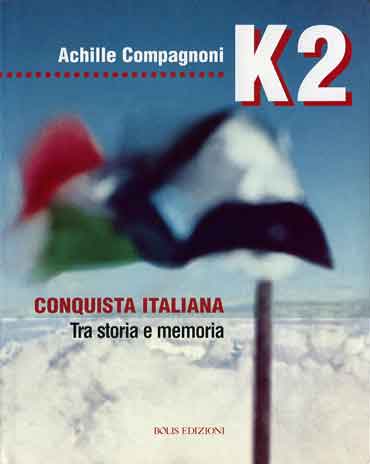
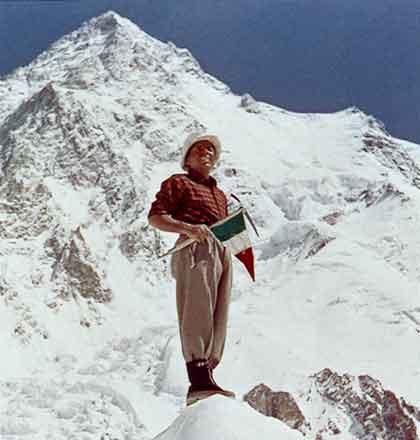
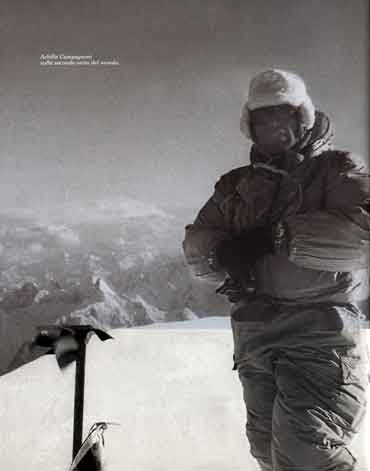
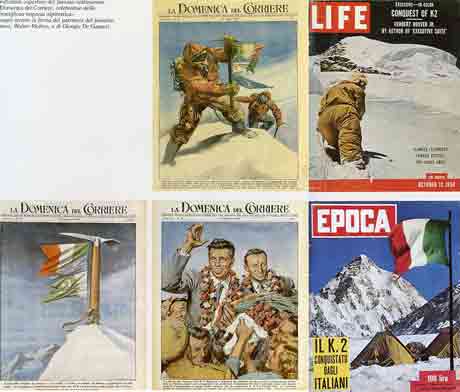

by Achille Compagnoni. Published 2004 to commemorate the 50th anniversary of the first assent of K2. In Italian. The book also contains the text of Compagnoni's 1958 book Uomini sul K2. There are 116 color and 63 b/w photos, many of the author.
The story follows the expedition as they trek to K2 Base Camp, at Base Camp, the death of Mario Puchoz, the climb of K2, and the return to Italy and all the magazine and newspaper articles and celebrations. There are some current photos of Compagnoni, and photos of some of the equipment they used in 1954.
I like this book for the many very good photos of the first ascent of K2 and the resulting celebrations in Italy.
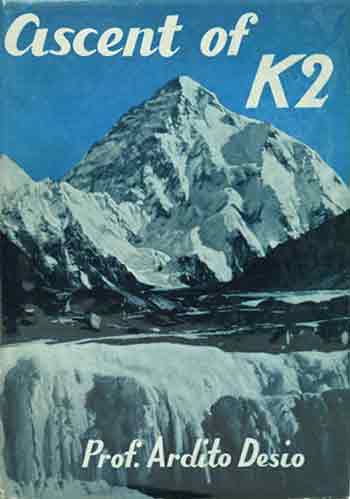
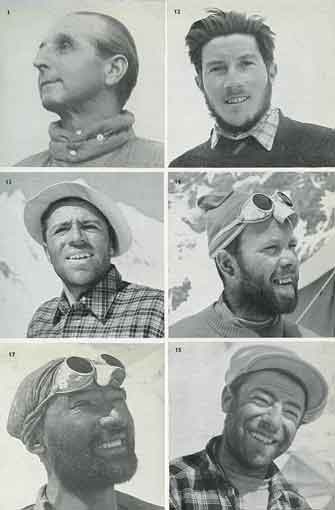
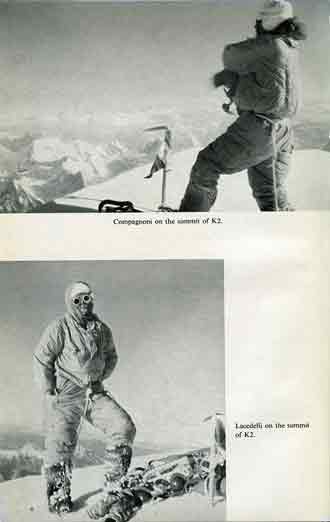

by Ardito Desio. First published in English in 1955. This is the official account of the 1954 Italian Expedition that completed the first ascent of K2, with Achille Compagnoni and Lino Lacedelli reaching the K2 summit on July 30, 1954. The cover is K2. There are 24 pages of b/w/ photos, and 3 maps.
Desio writes about previous K2 attempts and recognizes that what he learned from the 1953 American expedition was "not merely valuable but decisive." He describes his reconnaissance of K2 with Ricardo Cassin in 1953, selecting the climbers, and planning the food and equipment. He describes the trek to K2 Base Camp and using a pulley to winch supplies to Camps I, II, and III.
Tragedy hits the expedition when Mario Puchoz contracted pneumonia (now thought to be pulmonary oedema) and died on June 21. Desio pushed the team on, "The honour of Italian mountaineering was at stake.", and assigned Compagnoni as the leader on the mountain: "He was a man of iron will ... There is no denying, in fact, that in Compagnoni I had a most valuable ally. ... I had entrusted Compagnoni, who had revealed a staying-power and a determination that were altogether remarkable, with ‘the duty and responsibility of directing the attack on the summit’."
Although the book claims that the attack on the Summit chapter was described by Compagnoni and Lino Lacedelli, Lacedelli in his book K2: The Price of Conquest claims it was all Compagnoni. The location of Camp IX and Bonatti carrying the oxygen bottles up to the summit pair is glossed over. He claims that they picked up the oxygen bottles where Bonatti had left it that morning supposedly at 5am. He claims that the oxygen ran out but they left the masks and bottles on anyway.
"The ground was almost flat - now it was flat! We looked about us ... Above us there was nothing but blue sky ... We embraced each other, then flung ourselves down flat on the snow so that we could remove our oxygen-masks. Next we tied the two small flags – Italian and Pakistani – to an ice-axe, together with a small standard of the Italian Alpine Club." While Compagnoni gushes with personal satisfaction, "it would probably be true to say that we had both just experienced the greatest moment of our lies", Desio hits the nationalistic tone: "Lift up your hearts, dear comrades! By your efforts you have won great glory for your native land ... to-day all Italians are rising to acclaim you as worthy champions of your race."
The story is long and drawn out, and is told in a straightforward and boring manner. The photos are good.
My favourite K2 books:
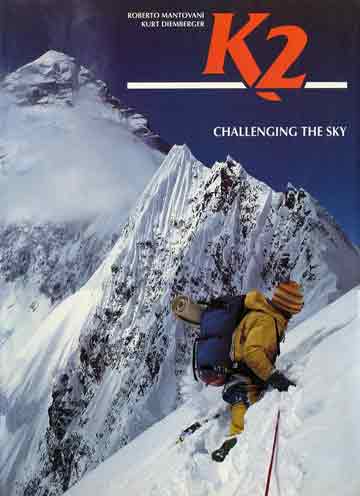
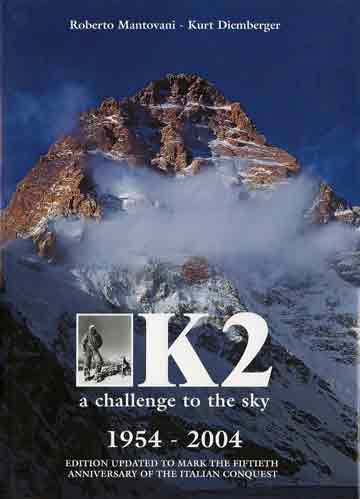
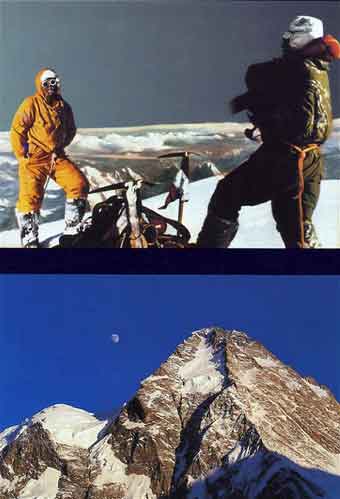
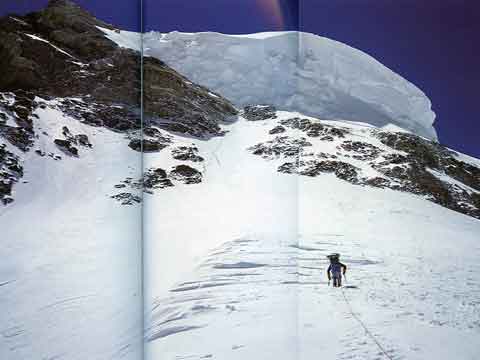

by Roberto Mantovani, Kurt Diemberger. Published in 1995 and republished in 2004. A beautiful coffee-table type book with spectacular photos and good information mostly from Kurt Diemberger's book Endless Knot. The book covers the history of climbing K2 from the earliest explorations up to the latest ascents completed in the 1990s.
Kurt Diemberger: A mountain as large and difficult as K2, with its height of 8,616 metres, and its unusually steep faces, and absolute atmospheric variability, is a whole "stage" higher than other 8,000-metre peaks in the Karakoram. Even though it cannot match Everest for its height, K2 is far more dangerous. Here even the very best climbers are tested to the limit. The mass climbing which is now common to most of the "lesser" 8000-metre peaks (and the classic Everest route), has no place on Quogir, "the Big Mountain". Otherwise the death toll could only increase.
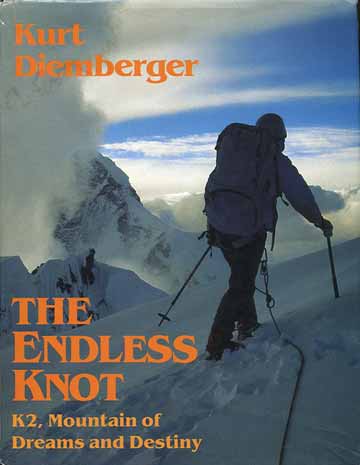
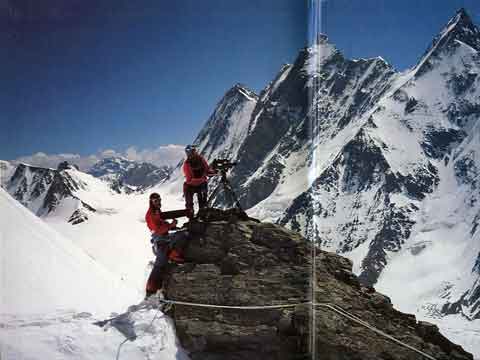
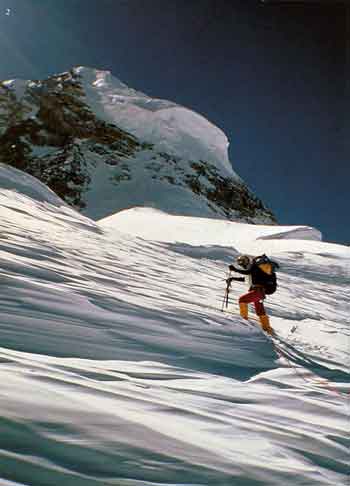
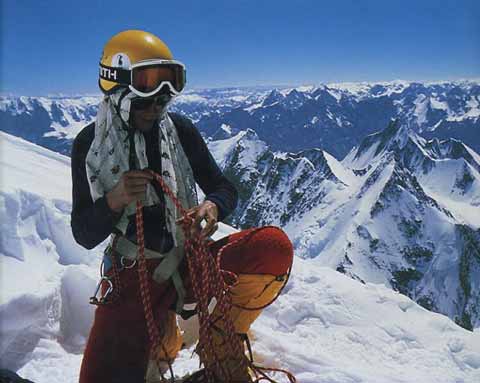

by Kurt Diemberger. First published in German in 1989 and English in 1991. In 1986 27 people reached the summit of K2, but 13 people died trying. Kurt Diemberger was on the mountain the entire summer, and was one of the seven people stuck on the Shoulder for seven days. Through his firsthand account and photographs we are there. The cover is Julie Tullis on the summit of Broad Peak in 1983 looking to K2 – her mountain of mountains. There are 28 pages of colour photos and 24 pages of b/w photos, 1 b/w photo in line with text, 4 maps, 2 climbing routes, and 3 illustrations. BP – cover, 4 colour, 3 b/w, some from 1957 K2 from the top of Broad Peak during the first ascent on June 9, 1957
The book starts with Kurt and Julie Tullis failing to climb the K2 north face in 1983, stopping due to a storm at 8000m. There is a 19-paqe chapter on their Broad Peak climb with Kurt Diemberger and Julie Tullis reaching the summit of Broad Peak on July 18, 1984. They suffered a hazardous descent in deep fresh snow and avalanches. Julie Tullis thus became the first British woman to climb an 8000er and, even better, to survive it.
Kurt and Julie were back in 1986 for another attempt on K2. He briefly describes the other teams on K2 and their attempts, successes and deaths. On August 2, 1986 Kurt and Julie climbed in perfect weather: "it’s sparkling and shining, twinkling from all sides in the morning sun – seracs, ice cliffs – it is a flood of light, everywhere, which catches, grasps you and carries you away." However a day later, "But there was the 3rd of August: the lost day. It was more than just Julie’s and my planned summit day. It was a fact: seven people idled the day away on the Shoulder of K2 in beautiful weather." In addition to Kurt and Julie, there were Austrians Willi Bauer, Hannes Wieser and Alfred Imitzer, Brit Alan Rouse, and a Polish woman, Dobroslawa Wolf. Kurt claims that the key factor in not moving was that the Austrians did not have a tent and had to squeeze into other tents, causing a sleepless night.
Alan Rouse was the strongest on summit day August 4, breaking trail most of the way, as the weather slowly worsened. Alan, Willi and Alfred reached the summit together at about 4pm. On the way down they found Wolf asleep in the snow and persuaded her to descend. Kurt and Julie reached the summit last at around 5:30pm. "The joy! The happiness! We cling to one another. For this one moment of eternity, K2 – beautiful K2 – is ours." Julie fell on the descent, pulling Kurt off, but they managed to stop their fall. They bivouacked at about 8400m, and descended the next morning in bad visibility to Camp 4, yelling to the people at Camp 4 to find their way. The storm continued to dump lots of fresh snow, causing Julie and Kurt to abandon their very small tent. Julie moved in with the Austrians, Kurt with Rouse and Wolf. Julie died on the night of August 7, telling Willi Bauer "get Kurt down safely". Diemberger was devastated.
The continuing storm kept them tent bound. "Sooner or later, I won’t have the strength left. There’s nothing to do, but wait. The wind decides." Alan became delirious, Mrowka immobile. "The flame of life flickers only in the innermost core of our souls. ... I am just a helpless wanderer up here between my dead friend and another who will die. And I know I have to get down." On the morning of August 10, after five days of unabated storm, the weather finally cleared enough to allow them to descend. Hannes and Alfred died a few steps from the tent. Willi led the descent, breaking trail. Kurt reached Camp 2 at 10pm with Willi already there making brews for them. Wolf was now missing. Kurt finally reached safety when Jim Curran met him on August 11 at midnight.
I really enjoy reading Diemberger's books, which have an almost lyrical and poetic writing style that expresses his love for life and climbing. Kurt's firsthand account of what happened on K2 in 1986 is riveting. The photos, most by Kurt, are very good
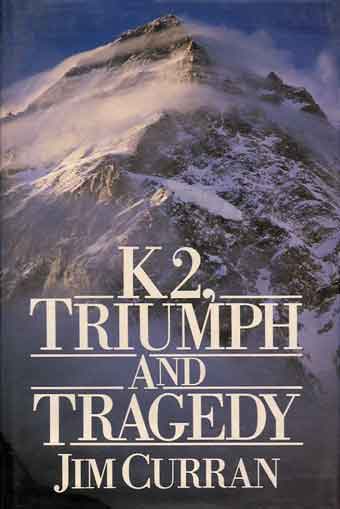
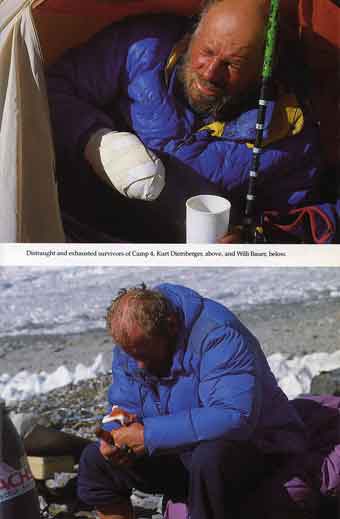

by Jim Curran. First published 1987. In the summer of 1986 nine expeditions converged on K2, the world’s second highest mountain, and 27 people climbed it. Thirteen were killed, seven of them after reaching the summit. The author was the cameraman for the 1986 British Northwest Ridge Expedition led by Al Rouse. After giving up at 7400m, Al Rouse switched to the Abruzzi Ridge. The author spent a lot of time at base camp and was able to meet many of the other climbers. There are 16 pages of colour photos.
There were several noteworthy climbs in 1986. Wanda Rutkiewicz became the first woman to climb K2 on June 23. Jerzy Kukuczka and Tadeusz Piotrowski completed the K2 South Face or "Polish Line" on July 7. Wojciech Wroz, Przemyslaw Piasecki and Peter Bozik completed the first ascent of the South-South-West Ridge (called the Magic Line by Reinhold Messner) on August 4.
The first tragedies of the summer happened on June 21 when Americans John Smolich and Alan Pennington were killed in a colossal avalanche. "Now on a beautiful calm day ... two lifeless bodies ... were lying somewhere on K2, their lives over and done. ... Suddenly everything looked different." The tragedies continued to mount throughout the summer with Maurice and Lilianne Barrard disappeared on June 24, Piotrowski fell to his death on July 10, Renato Casarotto fell into a crevasse on July 14, Wroz apparently abseiled of the end of a fixed rope on August 3-4, and high altitude sirdar Mohammed Ali was killed by stonefall on August 4. However, the biggest tragedy of 1986 on K2 was still waiting to happen.
Al Rouse, Willi Bauer, Alfred Imitzer, Kurt Diemberger and Julie Tullis made it to the summit on August 4, with Hannes Weiser staying at Camp 4 and Dobroslawa Wolf turning around before the summit. On August 5 a snowstorm with excessive wind and cold temperatures hit them, keeping the seven climbers tentbound at Camp 4. Julie Tullis died in her sleep on August 7. The sky finally cleared on the morning of August 10, and Diemberger, Wolf, Imitzer, Bauer, and Weiser immediately started down, leaving a delirious Al Rouse at Camp 4. Within a few hundred feet of leaving camp, Imitzer and Wieser collapsed and were left where they lay. With Bauer breaking trail, the other three kept fighting their way down. A few hours later Wolf dropped behind and did not reappear, and the team was down to two.
Jim Curran anxiously waited at base camp, and late on August 11 he met Bauer "staggering, stumbling and swaying from side to side". Bauer was able to tell him that Diemberger was still alive somewhere above, and Jim and two Polish climbers immediately set out to look for him. "As with Willi, my first feeling, was of horror, fear even. The shape got nearer and nearer and, almost colliding with him, I met Kurt. He was spreadeagled, facing into the slope, feebly kicking in his crampons ... Then distraught, he whispered, “I have lost Julie.” Kurt goes on to explain to Jim what happened.
In the appendices Wanda Rutkiewicz briefly describes becoming the first woman to climb K2 on June 23, Willi Bauer is interviewed the day after his return to Base Camp, and Benoit Chamoux describes his rapid 23-hour solo ascent of K2 on July 5.
Because the author wasn't an active climber, he spent a lot of time at base camp and met many of the other climbers, briefly describing people like Renato Casarotto and Goretta, Julie Tullis, and Kurt Diemberger. The writing is descriptive, humourous, and insightful. Jim's view is like that of a reporter, waiting at BC. Jim provides a very good summary commentary to analyze what happened, for example: "Once the gas ran out the fluid intake ceased, blood thickened and deterioration quickly followed."
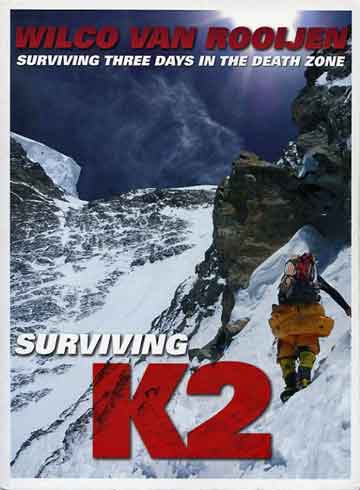
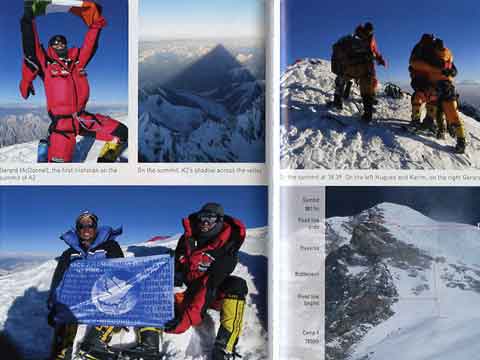
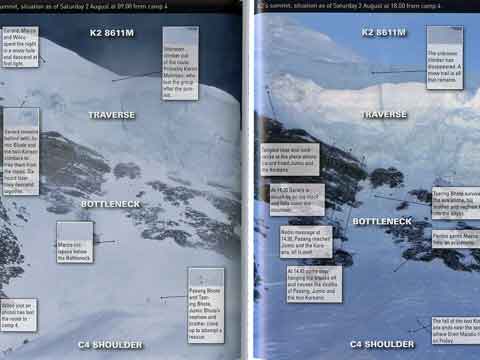

by Wilco van Rooijen. Published 2010 in English. The author describes his K2 attempts in 1995 and 2006 before telling the harrowing story of his survival during the deadly 2008 K2 season when 11 climbers died in a 36-hour period. There are 32 pages of colour photos. Wilco writes: "The difference between life and death, particularly on K2, is a thin elastic band. If you stretch it too far, it snaps. ... Those seracs are as huge as skyscrapers, cathedrals and they are teetering; no way stable. If any fragments were to collapse we wouldn't stand a chance."
ExplorersWeb gave their Best of ExplorersWeb 2008 Award to Gerard McDonnell: "The most selfless effort was made by Irish Gerard MacDonnell, who after two nights on K2's upper slopes including one in an open bivouac, resolved to alone stay and help two Korean climbers and a Nepali Sherpa, climbers he didn't know. Gerard knew well that his effort seriously put his own life at risk. His action is almost unmatched on the 8000ers. ... Gerard was called 'Jesus' by his peers. 'Hero' is a better word."
After briefly describing his ascent of the north face of the Eiger in July 1994, Wilco describes his first K2 attempt in 1995. Wilco describes in graphic detail how he got hit by a large rock above Camp 1, suffered a near fatal concussion, and had to be led down the mountain. Wilco's second K2 attempt was in 2006. He first attempted Broad Peak, but turned back between the false summit and the true summit because it was too late. He then turned to K2, climbing through the constant rock fall on the Abruzzi route. Teammate Gerald McDonnell was hit by a rock and had to flown out to a hospital in Skardu. Wilco's attempt failed below Camp 4 from bad weather.
Wilco returned in 2008 as the leader of the Norit K2 Expedition, attempting the Cesen route to the left of the normal Abruzzi route. Summit day August 1, 2008 began with Pemba Gyalje leaving Camp 4 on the Shoulder at 1:30am to help fix ropes in the Bottleneck, followed by Wilco, Gerard McDonnell, Jelle Staleman, and Cas van de Gevel at 2:30am. When Wilco reached the Bottleneck, he found that they had used fixed ropes on the easier lower portion and were now out of rope. Jelle decided to go down. Wasting valuable hours, they went down to retrieve the rope and then fixed it in the Bottleneck and Traverse. But, now there was a bottleneck of 19 people in the Bottleneck. Chris Klinke decided to go down, taking a spectacular photo showing the bottleneck of people. The first two fatalities occurred when Serbian Dren Mandic unclipped from the rope and fell to his death, and porter Jehan Baig slipped and fell trying to bring Mandic's body back to Camp 4.
"I crawl the last metres. I cannot believe it, we have made it!" Wilco van Rooijen, Gerard McDonnell, Cas van de Gevel, and Pemba reached the summit of K2 on August 1, 2008 at around 18:30. "We shout, we are happy, we are utterly exhausted. We hold each other, tears rolling down our cheeks." They leave the 'blissful feeling on the summit' and start to descend around 19:00 into "the hard reality of small ledges, slippery, black rocks, treacherous snow and immense ice masses."
Wilco, Gerard and the Italian Marco Confortola lose the route in the dark and bivouac in a snow hole. Ahead of them Norwegians Lars Nessa, Cecile Skog and her husband Rolf Bae were descending the Traverse to the Bottleneck in the dark when "a large section of ice breaks off and sweeps Rolf away. ... The rope that runs through the Bottleneck is also swept away." The climbers would now have to descend the Traverse and Bottleneck with only fragments of ropes to clip into. Lars and Cecile continue climbing down to Camp 4. Cas descended the Bottleneck in the dark, but when he reached the bottom he saw Frenchman Hugues D’Aubarede fall past him. Cas continued to camp 4 where Pemba was already melting snow.
The next morning Wilco, Gerard and Marco continue looking for the route, but when Wilco notices he was starting to go snow-blind he heads straight down as fast as he can. He stumbles onto a rope and finds the route, but finds two Koreans and Sherpa Jumic Bothe hanging upside down tangled in the ropes. A fourth Korean was already missing. Wilco doesn't have the energy to help them, and continues his descent. "What can I do? Nothing. I am at the end of my strength.. And here is a huge jumble of ropes and people. ... Life has been reduced to the essence of survival. Nothing more. ... I am hardly thinking, but acting on instinct." He loses the route again and when he reaches a very steep portion, he turns around and climbs back up to the ropes. He finally reaches the bottom of the Bottleneck, but he loses the way again in a thick mist.
Meanwhile, Gerard and Marco also come across the two Koreans and Jumic Bothe. They try, but can't untangle them from the ropes; so Marco descends. However, Gerard selflessly stays, and after six hours is able to free them, and they descend together. Gerard tragically is hit by a chunk of serac and falls to his death. Pemba climbed back up to help the barely conscious Marco just below the Bottleneck. Two of the Korean Sherpas, Pemba and Tsering, climbed back up from Camp 4 to help the Koreans descend. After reaching the summit with Marco, Pakistan Meherban Karim lost the route and apparently on August 2nd fell over the Serac. But then, another serac avalanche occurs. Tsering managed to jump out the way, as did Pemba at the Shoulder, catching Marco by the neck. However, the slide carried with it Jumic, Pasang, and the two young Koreans.
The lost Wilco has the bright idea to call his wife Heleen at home in the Netherlands. He asks her to call base camp in the Netherlands to call K2 Base Camp to call Camp 4 and have Pemba and Cas look for him. It works! Pemba calls him on the phone and tells him to descend straight, and that he and Cas will ascend, yelling to see if they can find each other. But once again Wilco veers off the route, with "blurry views and no points of recognition, I am alone in a dull, ice-cold world of snow, mist and rocks, and suffering from poor vision." He calls Heleen again to relay that he can't find Pemba, and continues his descent. "God, I feel so alone. This is the end ... Am I in heaven? Or have I checked into hell?" His eyesight starts to improve and he descends faster to about 7350m. "At this point back in Base Camp, Chris Klinke ... observes an orange speck [Wilco] moving slowly high up on the mountain to the left of the Cesen Route above camp 3." Base camp calls Pemba and Cas to descend to camp 3 and find Wilco. But night falls, and Wilco has to bivouac again, sitting near two dead climbers. "It is all weighing heavily: thirst, loneliness, the steepness, the cold, the dark. My feelings are numbed." Pemba reaches Camp 3, but Cas also has to bivouac, in fact only 300 metres from Wilco. The next morning Wilco starts to descend at first light and finds Cas. "We fall into each other's arms and cry." Pemba arrives and then they descend the mountain and the next day fly out by helicopter.
Exciting, frightening, and heroic story of the author's survival on K2 in 2008 and the heroic rescues of the stranded climbers, especially by Pasang, Gerard McDonnell, and Pemba. I really liked Wilco's tight writing style in keeping to the essence of the story, and sharing his first-hand experiences and what is going on in his mind. The photos are excellent, especially the Pemba Gyalje photos of the serac and the bottleneck area, showing the locations of the various mountaineers at 09:00 and 18:00 on August 2, 2008.
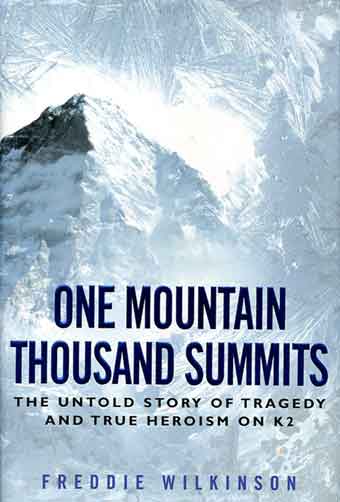
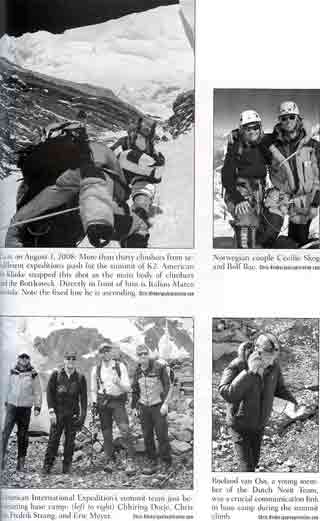
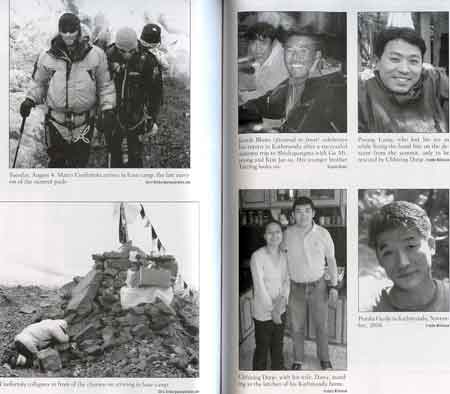

by Freddie Wilkinson. Published 2010. The mountaineer author tells the story of the 2008 K2 tragedy in two sections - one the story of how the story broke on the internet and in the media, the other focusing on the heroes including Gerard McDonnell, Pemba Gyalje, Tsering (Chhiring) Bhote, and Big Pasang Bhote. There are 8 pages of bw photos and two climbing routes.
Wilco van Rooijen, the leader of the Dutch Norit expedition, used his satellite phone to call in live updates to both his internet webmaster Marten van Eck and his wife Heleen on summit day and as the tragedy unfolded. Initially using the Norit website, the media frenzy started looking for more information fed from other blogs and people at K2 Base Camp. Where the Norit website was cautious in giving out only verified information, some of the other blogs and people gave more information, including speculation and rumours on what was happening. This fuelled some misinformation as the story continued to unfold, "until the spin itself threatened to taint the survivors' recollections and the factual evidence at hand." We also acutely feel the worry of those at home vigilantly watching the internet for any word of their loved ones.
For the second half of the book, the author interviewed many of the western survivors and travelled to Kathmandu several times to interview the surviving Sherpas to piece together the story. What he discovered was the selfless heroism that shone through the tragedy.
Gerard McDonnell selflessly worked for many hours to free two Koreans and Jumik Bhote who were tangled in ropes on the Traverse, only to be swept to his death when an ice avalanche from the serac hit him descending the Traverse. ExplorersWeb gave their Best of ExplorersWeb 2008 Award to Gerard McDonnell: "The most selfless effort was made by Irish Gerard MacDonnell, who after two nights on K2's upper slopes including one in an open bivouac, resolved to alone stay and help two Korean climbers and a Nepali Sherpa, climbers he didn't know. Gerard knew well that his effort seriously put his own life at risk. His action is almost unmatched on the 8000ers. ... Gerard was called 'Jesus' by his peers. 'Hero' is a better word."
Pemba Gyalje, Chhiring Dorje, and Pasang Lama down climbed the Traverse and Bottleneck to Camp IV in the dark without fixed ropes with pieces of the serac falling around them and Pasang Lama without an ice-axe. Pemba Gyalje went back up the next day to bring down Marco Confortola who had fallen asleep at the bottom of the Bottleneck. After rousing Marco and starting to descend, an ice avalanche occurred and Pemba grabbed Marco and was able to pull him out of the way of the falling ice, covering him with his own body. Later Pemba went out in search for the lost Wilco van Rooijen and, after Wilco was spotted descending slightly off the Cesen route, descended to Camp III and the next day found Wilco and helped him back to base camp.
Tsering (also spelled Chhirring) Bhote, Jumik's brother, and Big Pasang Bhote left Camp 4 at midnight on August 1 to climb up to the stranded climbers, but they found a lost Korean Go Mi-sun and brought her back to camp IV. The next morning they went out again to climb to the stranded climbers, found Marco at the bottom of the Bottleneck and phoned Pemba Gyalje to come up and bring him down. The ice avalanche (where Pemba saved Marco's life) killed Big Pasang Bhote, the two Koreans and Jumik Bhote. Luckily, Tsering Bhote was a bit lower than Big Pasang Bhote and was able to run to some large rocks that protected him.
I highly recommend this book to understand the frightening and heroic story of K2 in 2008 from the internet and media perspective, the heroic rescues of the stranded climbers, and providing insights and details of the Sherpas involved. The use of sat phones to provide live feeds to internet websites and blogs, and how the media frenzy unfolded is interesting and reflects so much modern media stories. I enjoyed reading about the Sherpas, their personalities, how money fuelled them to become climbers, and how they live in Kathmandu. I was disappointed in the small number of photos, and only black and white.
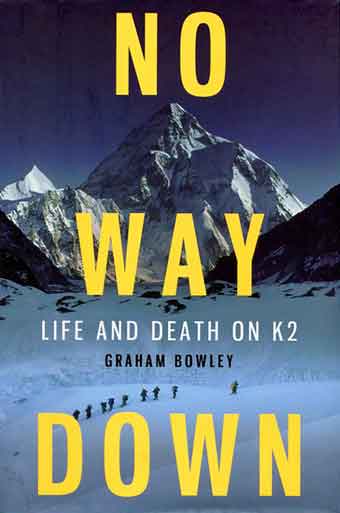
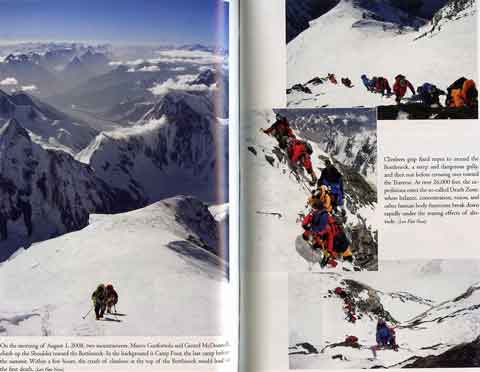
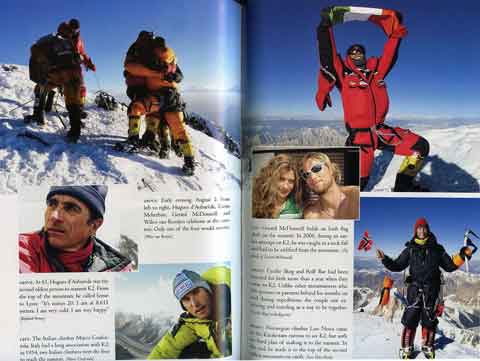
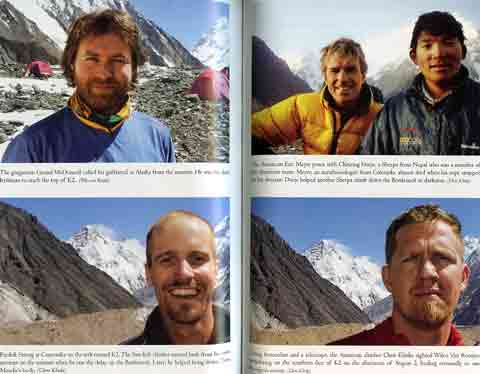

by Graham Bowley. Published 2010. The New York Times reporter interviewed most of the survivors and many other people involved in the 2008 K2 tragedy to tell the minute-by-minute story. Each of the climbers is briefly profiled. There are 16 pages of colour photos, many by Lars Flato Nessa, and one map.
The book starts with American Eric Meyer and Swede Fredrick Strang climbing to the Bottleneck on August 1, 2008, and seeing that there was a bottleneck of slowly moving climbers in front of them, turning around and going back to Camp IV. The other climbers continued, but Serbian Dren Mandic unclipped from the rope and fell to his death. Meyer and Strang climbed back up to help them bring down Mandic's body, but then porter Jehan Baig slipped and fell to his death. Later that night, they used a strobe light to try and direct returning climbers.
Spaniard Alberto Zerain switched from Broad Peak to rush up K2, moving to the head of the climbers, fixing ropes through the Traverse and then breaking trail all the way to the summit. He sat on the summit for awhile and then at 15:40 started his descent. He passed the other ascending climbers an hour later, and continued his descent safely to Camp III.
Norwegians Cecile Skog and young teammate Lars Flato Nessa reached the summit around 17:30. On their descent, Cecile re-joined her husband Rolf Bae who had stopped on the summit snowfield. Rolf led the three of them as they descended through the Traverse just after dark. "But at that point, the mountain began to shake. There was a precise crack and roar. ... the rope ended abruptly, as if cut by a knife." Rolf Bae had been killed by the first serac ice avalanche, and now there was no fixed rope to help the climbers behind to climb through the Bottleneck. After down-climbing the Bottleneck without ropes, Cecile slipped and fell but was able to self-arrest using her ice-axe. Cecile and Lars continued safely to Camp IV.
After reaching the summit, most climbers climbed down together, with Jumik Bhote from the South Korean expedition leading the way, but the farther they descended the more they split apart. Chhirring Dorje from the American expedition reached the Traverse and called Meyer and Strang at 22:30, "No ropes! ... No rope left on the Bottleneck. Big problem. Many danger." Chirring Dorje caught up to Pemba Gyalje from the Norit Dutch expedition, and Little Pasang Lama, who didn't have an ice axe, from the South Korean Expedition, "We climb down. There is no other choice." They carefully climbed down the Bottleneck and made it safely back to Camp IV at 1:30.
Korean Sherpas Chirring Bhote, Jumik Bhote's brother, and Big Pasang Bhote left camp IV at midnight, carrying supplies for the stranded climbers. After meeting the three Sherpas and Korean Kim Jar-Soo, they saw a body falling past them. They then found Korean Go Mi-Sun, who had gotten lost at the bottom of the Bottleneck, and helped her back to Camp IV around 4:30am. After a brief rest, the two Sherpas packed more supplies and went out again.
Jumik Bhote urged the three South Koreans to descend the rope from the snowfield to the Traverse around 2am, but they wouldn't move. "The rope dropped suddenly and in a dark, roaring, confusing rush, Bhote catapulted past the South Koreans. He crashed painfully into the ice a little way below them and stopped." When he looked up he only saw 2 Koreans, both suspended headfirst. "Bhote didn't want to die. He didn't want his family to be mourners, walking to the puja at the Boudha stupa." But there was nothing he could do but wait for rescue.
Cas van de Gevel from the Norit Dutch Expedition passed Frenchman Hughes d'Aubarede at 1am and was downclimbing the Bottleneck when he saw a body fall headfirst past him wearing a dark yellow down suit - it was Hughes. Cas reached Camp IV at 2am.
Italian Marco Confortola and Norit member Gerrard McDonnell lost the trail on the summit snowfield and decided to bivouac. Norit Expedition leader Wilco van Rooijen got lost too, but found Marco and Gerard and bivouacked with them. Wilco was going snowblind so he left at first light racing down. He passed Jumik and the two Koreans, figuring in his own state he couldn't help.
Marco and Gerard followed Wilco and also found Jumik and the two Koreans. After about 3 hours trying to help the stricken climbers, Gerard climbed up past the serac and Marco, now alone, decided to climb down. Marco fell, but was able to stop himself. Another ice avalanche burst from the head of the serac, stopping only about 10 metres from him. Marco noticed parts of a dead climber, including yellow and black boots. He assumed this was Gerard, but it probably was Hughes' missing HAP Karim Meherban. Marco continued the climb down to the bottom of the Bottleneck, sat down and fell asleep.
Chhirring Bhote and Big Pasang Bhote found Marco asleep at the bottom of the Bottleneck and called Pemba Gyalje to come up and bring him down. Pemba carried oxygen up to Marco, who started to recover. Big Pasang Bhote called Pemba Gyalje on the radio and gave him the good news that Jumik Bhote and the two Koreans had been freed and were now climbing down. He also mentioned a fourth climber behind them had been killed by another piece of the serac. Big Pasang Bhote identified him as having a red and black down suit - Pemba's heart fell, it must be Gerard. Five minutes later another ice avalanche occurred and Pemba grabbed Marco and was able to pull him out of the way of the falling ice, covering him with his own body. "But several yards below them, visible through the cold fog, four bodies were lying scattered on top of the snow," - Big Pasang Bhote, Jumik Bhote and the two South Koreans. Chhirring Bhote had lagged behind Big Pasang Bhote and was near a clump of big rocks which protected him when the avalanche hit.
Almost blind, Wilco lost the trail and called his wife on his sat phone. She was able to get a message to Pemba Gyalje at Camp IV. Pemba went out again but was unable to find Wilco. American Chris Klinke used binoculars from base camp and spotted Wilco at 17:30 descending slightly off the Cesen route. They radioed Camp IV and Pemba Gyalje and Cas descended the Cesen route trying to find Wilco. Pemba reached camp III, but couldn't find Wilco. As night fell, both Wilco and Cas had to bivouac. The next morning Pemba found Wilco and Cas and helped Wilco back to Base Camp, a survivor in the midst of the tragic events.
I highly recommend this book to get the best perspective on the minute-by-minute timing of the events and all the players in the 2008 K2 tragedy. The photos are excellent. Unlike ExplorersWeb and Freddie Wilkinson, Bowley is not willing to identify Gerard as a hero since he considers the evidence inconclusive.
For one man's harrowing story of survival, I recommend Surviving K2 by: Surviving Three Days in the Death Zone by Wilco van Rooijen. For a minute-by minute summary of the events, including all the players in the K2 2008 tragedy, I recommend No Way Down: Life And Death On K2 by Graham Bowley. For a perspective on the ensuing media frenzy and the heroes of the tragedy, Gerard McDonnell, Pemba Gyalje, Chhiring Dorje, and Pasang Lama, I recommend One Mountain Thousand Summits: The Untold Story Of Tragedy And True Heroism On K2 by Freddie Wilkinson. Ed Viesturs devotes a chapter of his excellent book K2: Life and Death on the World's Most Dangerous Mountain to share his views on the heroes and the contributing factors to the tragedy.


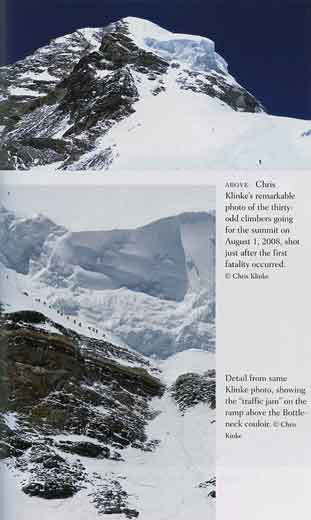

by Ed Viesturs, David Roberts. Published 2009. America's first mountaineer to climb the 14 8000m peaks, Viesturs describes the major events on K2 along with his personal views. Ed examines "the questions of risk, ambition, loyalty to one's teammates, self-sacrifice, and the price of glory", sharing his direct honest opinions, like: "jerk", "I just don't buy it", "why didn't he get out and do something", and "that directive strikes me as questionable at best". I myself firmly believe in Ed's approach - getting into great physical shape with a thoroughness and intensity of preparation and planning, being a clock watcher and on time, non-confrontational, carrying your own weight, and being patient.
You should buy this book first and foremost for Viesturs account of his own summit of K2 in 1992, second for his opinions of the controversial 1939 U.S. expedition led by Fritz Wiessner, third for his critique of the August 2008 season where 11 climbers died in a 36-hour period, and finally as a history of the main events in K2's history, including 1938 U.S. reconnaissance expedition, the 1953 U.S. expedition, the controversial first ascent by the Italians in 1954, and the terrifying 1986 season that left 12 dead. There are 8 pages of colour photos (4 from Viesturs K2 ascent in 1992), 8 pages of b/w photos, a 2-page map, and one b/w sketch.
The book starts with Ed critiquing the 2008 tragedy where 11 climbers died in a 36-hour period. He clarifies the misconception that they were all killed when pieces of the frightening large ice serac above the bottleneck fell off. He also states that the real heroes were the Sherpas, unselfishly going back up the mountain to rescue climbers. Ed critiques the dependency on fixed ropes, the lateness of leaving Camp 4 and reaching the summit, and the fact there were no wands to help people find the route.
My favourite chapter is when Ed tells the true story of what happened on his ascent of K2 with Scott Fischer and Charley Mace on August 16, 1992. I was disappointed with No Shortcuts To The Top because the stories were too short and too 'perfect'. Not in this book. Ed uses his diaries to share his innermost raw, blunt, and critical feelings and opinions, highlighting his problems with his teammates and other teams, and lack of leadership. It is tight, entertaining, tense, emotional, an epic! This chapter could have been the whole book and I would have been happy.
Ed and Scott had to put off their own attempt to rescue two climbers. Although Ed is normally risk averse, he and Scott accepted danger to try and rescue two climbers. They were caught in an avalanche, but Ed was able to self-arrest and stop their fall. Ed comments on once again accepting too much risk on summit day: "As we got closer to the summit and the falling snow showed no signs of letting up, I knew I was making the greatest mistake of my climbing life. And yet I kept going. ... Scott, Charley, and I broke free of the clouds just short of the summit. We saw it shining in the sun ahead of us. At noon, we stood on top, hugging each other and gasping in the thin air. ... After only thirty minutes on top, we headed down. ... Soon we were stumbling downward in a thickening whiteout." After reaching Camp 4 at 5pm, he wrote in his diary: "We'd pushed our luck beyond the max. I hope I never do that again! No summit is worth dying for. You can always come back." When they reached Camp 4, they found Rob Hall dealing with a very sick Gary Ball suffering from cerebral edema. They now had to help Gary down in bad weather and terrible avalanche danger. They found Ed's wands in the deep snow, which saved their lives by showing them the correct route down. "I don't think I've ever been more physically or emotionally exhausted in my life after that climb and descent."
After a brief history of the 1902 attempt by Oscar Eckenstein and Aleister Crowley and the 1909 attempt by the Duke of Abruzzi with Vittorio Sella, Ed describes in straightforward detail the 1938 US reconnaissance expedition led by Charlie Houston, quoting sections from "Five Miles High". After reconnoitering the Northeast and Northwest sides, the team decided that the Abruzzi was the best choice. After setting up camps on the ridge, Bill House climbed a great slanting gash in an almost vertical rock now called House's Chimney, and Charlie Houston and Paul Petzoldt reached 7920m feet before turning back due to not enough food and equipment at the highest camp.
My second favourite chapter is when Ed's writing is once again opinionated and enlightening as he describes the controversial 1939 US expedition led by Fritz Wiessner, who had recently immigrated to the US from Germany. After the best climbers dropped out, Fritz had to lead an inexperienced and weak team. Fritz led all the way, breaking trail, and turned back at 8380m just below the easy summit snowfield when Pasang Lama wouldn't go on. After a second attempt failed because Pasang had lost his crampons, Wiessner and Pasang descended to Camp VIII, only occupied by Dudley Wolfe. On the descent the three climbers fell, but Wiessner was able to self-arrest, stopping their fall. Viesturs thinks that "only Pete Schoening's 'miracle belay' in 1953 is more legendary than Wiessner's self arrest." Unknown to Wiessner, all camps below camp VIII had been stripped supposedly because they thought that the summit party had been killed. The attempt to rescue Wolfe failed, with Wolfe and three Sherpas perishing on the K2 Shoulder. Ed thinks that "any climber has to be in complete awe of Wiessner's performance on K2." and considers his logistical plan "brilliant" Viesturs calls much of the criticism in the 1992 book K2: The 1939 Tragedy by Andy Kaufman and William L. Putnam "cockeyed", especially the fact that Wiessner led from the front, leaving Wolfe at camp VII on the descent, and what he considers the racial profiling of Wiessner.
Next, Ed describes the 1953 U.S. expedition led by Charlie Houston, calling it "the high point of American mountaineering", and "The courage, devotion and team spirit of that expedition have yet to be surpassed." He quotes from "K2: The Savage Mountain" and from Dee Molenaar's never released diary. A storm hits and they have to remain at Camp VIII for seven days, with Art Gilkey developing thrombophlebitis. In very bad weather and high avalanche danger, the rest of the team attempt to lower Gilkey down the mountain. Pete Schoening performed "the most famous belay in mountaineering history" when he singlehandedly stopped the fall of six teammates with "a single axe and a grip of steel." But the rescue ended in tragedy a few minutes later when Gilkey was avalanched to his death.
The camaraderie and teamwork of the 1953 U.S. team fades into intrigue and back-stabbing on the first ascent of K2 in 1954 by Italians Lino Lacedelli and Achille Compagnoni, with Walter Bonatti becoming a very convenient villain and an ideal sacrificial goat. Walter Bonatti and Pakistani Mahdi carried oxygen bottles to Camp IX, but had to suffer a bivouac at 8100m when Compagnoni intentionally moved the camp from the planned site so Bonatti could not try for the summit. Once back home, Bonatti was silently and later publicly accused of treachery, trying to steal the summit, and using their oxygen. Ed describes it as "a feud so sordid, bitter, and long-lasting that it has few parallels in mountaineering history." Vindication came in 2004 when Lacedelli agrees with most of Bonatti's views in his book K2: The Price of Conquest.
Finally, Ed describes in straightforward detail the tragic 1986 climbing season when 13 people were killed, quoting from Kurt Diemberger's The Endless Knot and Jim Curran's K2: Triumph and Tragedy. After eight unrelated deaths, a snowstorm with excessive wind and cold temperatures hit seven climbers, keeping them tent bound at Camp 4. Julie Tullis died in her sleep. After several days, in a break in the storm, Kurt Diemberger, Dobroslawa Wolf, Alfred Imitzer, Willi Bauer, and Hannes Weiser immediately started down, leaving a delirious Al Rouse at Camp 4. Within a few hundred feet of leaving camp, Imitzer and Wieser collapsed and were left where they lay. With Bauer breaking trail, the other three kept fighting their way down. A few hours later Wolf dropped behind and did not reappear, and the team was down to two. Bauer and Diemberger staggered and stumbled their way down the mountain.
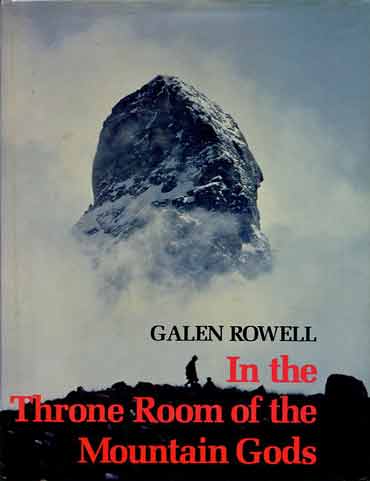
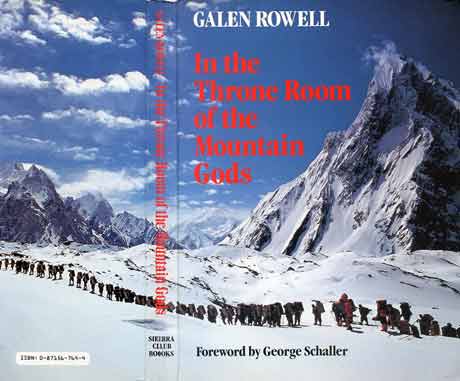
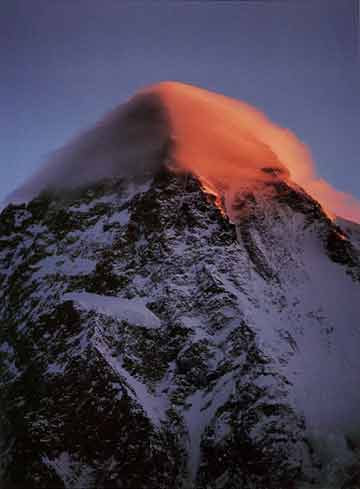
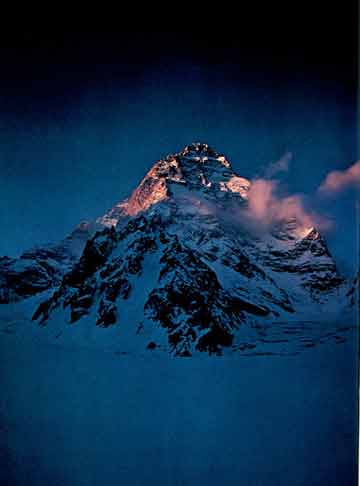

by Galen Rowell. One of Michael Chessler's Top 100 Mountaineering Books. First published 1977, which has 48 pages of colour photos and 167 bw photos in-line with text. The 1986 edition also contains 48 pages of colour photos, but some photos from the 1977 edition are missing, replaced with Galen's 1980 ski traverse of the Karakoram via the Biafo Glacier. There is an excellent 2-page map of the Baltoro Glacier. This is the story of the 1975 American K2 Expedition attempting the unclimbed Northwest Ridge. Rowell uses the diaries of the team members, especially Jim Wickwire and Leif Patterson, to add to the story.
The team quickly broke into two factions with the leaders Jim and Lou Whittaker and Jim Wickwire sparring against the rest of the team. "I was especially concerned about the pettiness, the tendency to make major issues out of minor things." Galen sought out stories of the land, the animals, and its people. The porter problems with daily strikes added to the team tensions and problems just to get to base camp. "[Fred Dunham] felt that he was constantly being ridiculed, put down and ignored." Rowell sums it up: "a ruthless brand of militant enthusiasm that runs roughshod over friendships, health, safety, and reason."
The team gave up their attempt just a month after reaching Base Camp in early July, contrasting with their 1978 success when they went well into September. Wick: "Our further progress along the ridge ... seemed out of the question. Extremely steep on both sides (75 to 80 feet), the ridge was a knife-edge between the pinnacles ... The quest for height on K2 was over."
Much of the book is devoted to the history of K2, including Conway and Eckenstein in 1892, Eckenstein and Crowley in 1902, the Duke of Abruzzi and Vittorio Sella in 1909, Charles Houston and the Americans in 1938, Fritz Wiessner and the Americans on the 1939 tragic expedition, Charles Houston and the Americans in 1953, and the first ascent of K2 in 1954 by the Italians.
Buy this book for the excellent photos and history of K2 - I prefer this book to Jim Curran's book K2 The Story Of The Savage Mountain. In a way, this is a depressing book to read, given all the porter problems and the team animosity. Because there wasn't much climbing on the expedition, the pace is a bit slow.
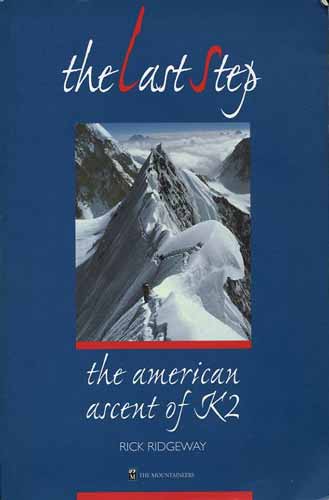
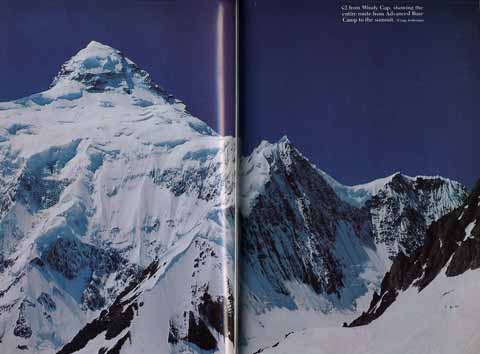
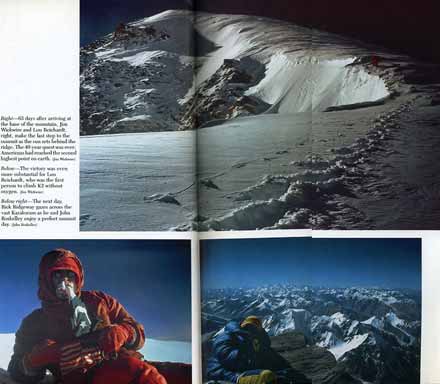

by Rick Ridgeway. First published 1980, reprinted 1999. One of Michael Chessler's Top 100 Mountaineering Books. This book describes the first American ascent of K2 via the difficult northeast ridge, with Jim Wickwire and Lou Reichardt reaching the summit on September 6, 1978, Lou being the first person to climb K2 without oxygen. John Roskelley and Rick Ridgeway reached the summit the next day, both without oxygen. There are 32 pages of colour photos and 2 route diagrams. "The last step depends on the first … the first step depends on the last."
Expedition leader Jim Whittaker, Jim Wickwire, Rob Schaller, and Diane Roberts returned to K2 in 1978 after failing in 1975. With them were new members John Roskelley, Lou Reichardt, Craig Anderson, Terry and Cherie Bech, and Skip Edmonds. There is a good description of each member of the team, and of the trek to base camp. Roskelley also uses some of the other team member’s journals, especially Jim Wickwire, to add to the story.
John Roskelley and Rick Ridgeway led the most difficult section of the northeast ridge. "We were climbing on the edge of a knife. The slope dropped away on both sides, steeply, dramatically, to glaciers thousands of feet below. ... Twelve hundred feet of steep ridge was behind us, fixed with rope." Like 1975, personality problems were again prevalent in 1978, "the acrimony and animosity, the poison, that were to divide our team." The lead climbers jockeyed for position on the summit teams, and were more determined and willing to take additional risks over the more conservative climbers. After reaching their top camp, Jim Wickwire and Lou Reichardt decided to try the Abruzzi, while John Roskelley and Rick Ridgeway attempted the direct route to the summit. John and Rick had to turn back due to avalanche danger. "after sixty-two days on the mountain, after the weeks and months of struggling through snow, of climbing across steep ice, of carrying load after load to higher camps; that after six storms and the days and days spent holed up in tents; that after so many frustrations followed by reborn hopes by still more disappointments and new frustrations, they (Jim and Lou) were now poised to be, after forty years of questing, the first Americans to make that last step to the summit of K2."
Lou Reichardt and Jim Wickwire reached the K2 summit on September 6, 1978 at 17:15pm. "The summit of his dreams, Wick stared across the mountains stretching endlessly below him, summit after summit painted gold. They were all below him. The world curved away, in all directions, falling away, below his feet. For Lou, it was an even more remarkable victory. He was the first man to climb K2 without oxygen." Lou quickly left the summit at 17:30 and reached Camp 6 late that evening where John and Rick were planning their ascent. Wick lingered until 18:15 on the summit and had to suffer through a horrible bivouac just below the summit. Wick: "What a place this would be to spend an eternity. Frozen up here forever on the summit of K2. The highest man in the world. ... Be careful. You’ll be down soon. I’m coming home, Mary Lou. I love you." Wick was able to descend, but eventually got pneumonia complicated with pleurisy and had to take a rescue helicopter near Paiju. Rick Ridgeway and John Roskelley reached the summit the next day, on September 7 at 15:30 without oxygen. "No wind. No Clouds. Cerulean sky, brilliant sun ... Nothing quite real, the feeling of a dream. ... John crawled up behind me, and together we sat on top, holding each other, too exhausted to speak."
This book is well written, exciting and insightful. For a big book, it has a good pace and is not boring. Wick’s description of his thoughts during the bivouac was frightening. I think that maybe the author dwelled on the personality problems too much. The photos are excellent.
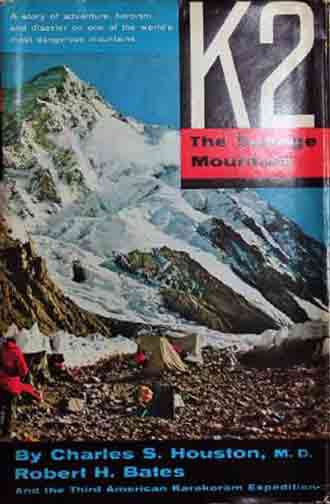
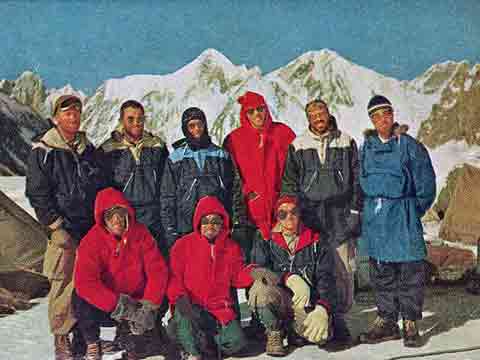
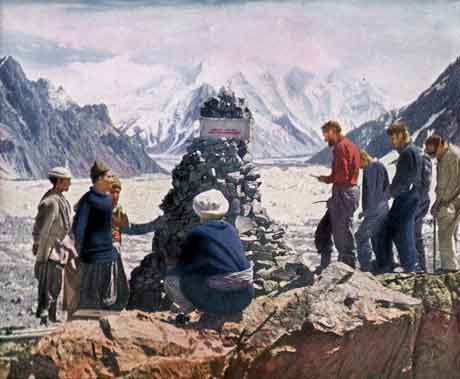

by Charles H. Houston and Robert H. Bates. First published 1954. One of Michael Chessler's Top 100 Mountaineering Books. After their 1938 reconnaissance expedition, Houston and Bates returned to K2 in 1953 to attempt the summit. The appendices detail the chronology, equipment, food, medical problems, finances, and transport of the expedition. The cover is K2 from Base Camp. There are 8 pages of colour photos, 16 pages of b/w photos, and 2 maps and 16 line drawings by Clarence Doore. The 2000 reprint is an exact copy of the original 1954 book except all photos are b/w.
The 1994 Adventure Library edition has 14 pages of colour photos (some not in the 1954 book), 2 pages of colour sketches from Dee Molenaar, and 11 b/w sketches in-line with text from Dee Molenaar, and one b/w photo in-line with text. There is an excellent map of the Baltoro area on the inside covers. There are up-to-date biographies of all 9 team members, each with a small b/w photo. It also has a 25-page transcript of the tape made the day the team got back to Base Camp on August 16 1953, and another 10 pages from the team's discussion at their reunion in 1994. The appendices contrast the equipment, food, medical problems, finances, and transport in 1938, 1953 and 1994.
The book starts with a brief history of previous K2 attempts, and then follows the team to Skardu, trekking to Askole and on to Base Camp. They climb the Abruzzi spur, carrying their own loads, using a pulley on House’s Chimney. They slowly set up camps, and on August 2 eight mountaineers are in Camp VIII, ready to attempt the summit. "Morale was magnificent. We were within striking distance of the goal. The summit might still be ours." But then in shades of the 1986 K2 tragedy, a storm hits and they have to remain at Camp VIII for seven days However, on August 7, "As Art Gilkey crawled out to join us, he collapsed unconscious in the snow. ... Art had developed thrombophlebitis. ... There was no hope, absolutely none. Art was crippled. He would not recover enough to walk down. We could not carry him down. But we could try, and we must."
They wrapped Gilkey in a sleeping bag and began lowering him down towards Camp VII on August 10, changing the route to a rocky cliff to avoid avalanche danger. "I never saw Bell fall, but to my horror I saw Streather being dragged off the slope ... In almost the same instant I saw Houston swept off ... a terrible jerk ripped me from my hold." Three separate ropes luckily got tangled together as the five men fell. "the whole strain of the five falling men, plus Gilkey, was transmitted to Schoening. ... a solitary ice axe with its pick end jabbed into the ice. ... One man had held five men who slid 150 to 300 feet down a 45-degree slope and that he had done it at nearly 25,000 feet"
They anchored Gilkey and went to Camp VII to set up the tents. When they went back to get Gilkey, an avalanche had ripped him from the anchors, "The whole slope was bare of life. Art Gilkey was gone!" The descent was harrowing in stormy conditions and with Houston in shock from a concussion, and Bell with frostbite in his feet and hands. They set up a memorial cairn to Gilkey near Base Camp. "Except for the dull ache of Gilkey’s loss, we felt at peace with the world. ... We had done our best and had survived."
The story is told in a straightforward manner, brief and to the point. The accident is a gut wrenching episode.
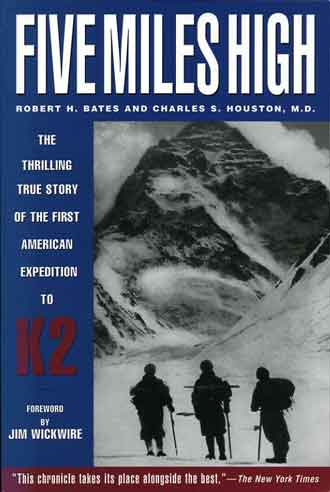
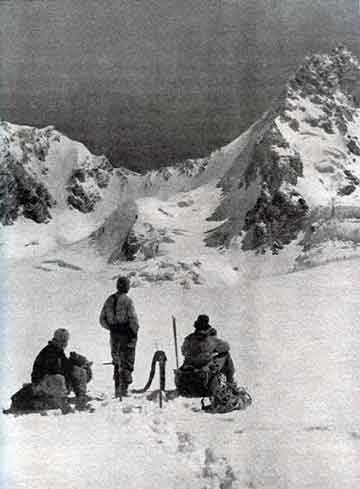
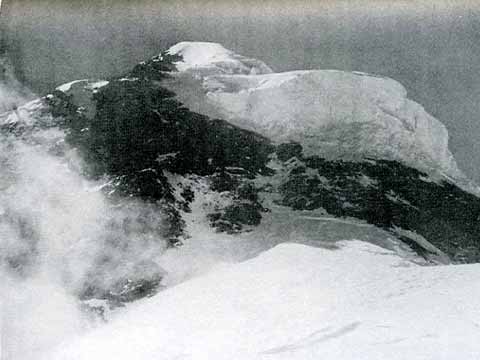

by Robert H. Bates and Charles H. Houston. First published 1939, reprint 2000. Other chapters were written by William House and Richard Burdsall. One of Michael Chessler's Top 100 Mountaineering Books. The 1938 American Karakoram lightweight expedition of 6 climbers and 6 porters explored five K2 ridges before establishing the most feasible route by climbing the Abruzzi Ridge, and nearly reaching the summit of K2. The cover is K2 West Face. There are 31 pages of b/w photos.
The story starts with a brief history of K2 exploration, selecting the team, food, and equipment. Nearly half the book is taken up with the trip to K2 Base Camp, taking one month from Srinagar by ponies and then trekking from beyond Skardu. They explored five main ridges: the Northwest and West ridges from the Savoia Glacier, the Southwest from the Angelus, the Southeast Abruzzi ridge, and the Northeast. And then settled on the Abruzzi Ridge as the most feasible.
Bill House climbed a great slanting gash in an almost vertical rock to surmount the first main difficulty of the Abruzzi Ridge, now called House's Chimney. House: "With feet and hands gripping both sides, I climbed up 20 feet to where the walls flared outward and became so smooth that I had to put my back against one and feet against the other to hitch myself up a few inches at a time."
Houston and Petzoldt overcame the second main difficulty of the Abruzzi Ridge, they called the Black Pyramid. Houston: "We felt that the last thousand feet leading onto the great shoulder was by far the most difficult and inaccessible stretch of all. ... Shortly after noon we shook hands at the top of the Black Pyramid at an altitude of approximately 24,500 feet. Abruzzi ridge had been conquered and we had found a route to the snow fields of the 25,000-foot shoulder."
With the summit within their grasp, the team decided that safety came first, so they agreed that Houston and Petzoldt would continue climbing for only three days. Houston: "At last, at the base of the final cone, I could go on no farther. Petzoldt was 150 feet above me, working on the rock. ... A deep and heartfelt regret at abandoning the attack, when success seemed within our grasp."
Written in a fairly straightforward style, the story of exploration and discovery is very interesting. You can just about feel the excitement turning to frustration as they attempt the different ridges, and then have to withdraw. Even the Abruzzi looked doubtful until they stumbled on a place for the first campsite. The photos are very good.
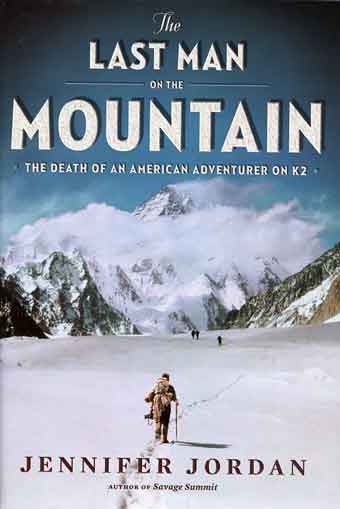
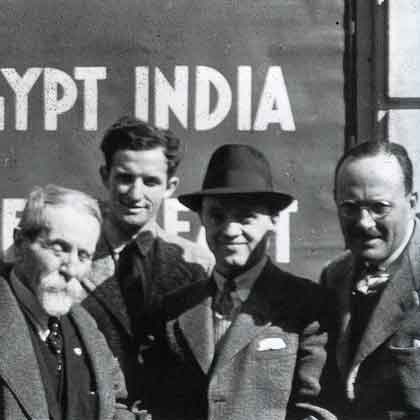
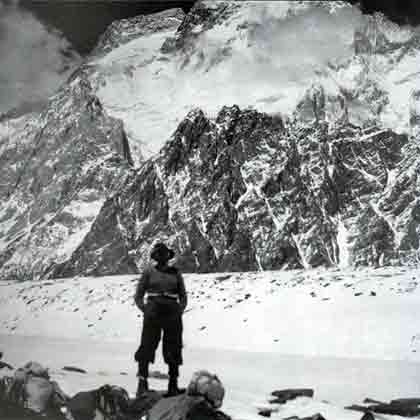
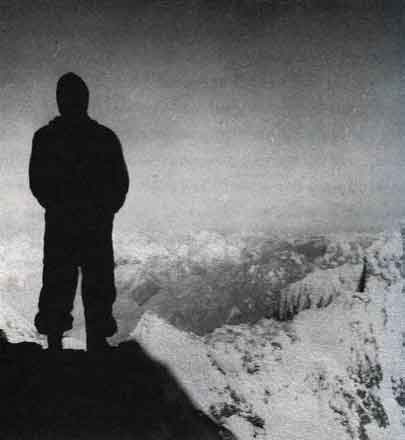

By Jennifer Jordan. Published 2010. After finding the remains of Dudley Wolfe in 2002, the author researched the story of the controversial 1939 American attempt on K2 to reveal in detail Dudley's story. Leader Fritz Wiessner and Pasang Lama came within 244m of the K2 Summit, but the expedition ended in tragedy when Dudley Wolfe and three Sherpas perished on the K2 Shoulder. There are 17 pages of bw photos, 15 extra bw photos, many by George Sheldon.
The book starts with the author finding Dudley Wolfe's skeletal remains near K2 Base Camp in July 2002. The book describes how Dudley joined the 1939 K2 expedition - mainly because he was rich and could help fund the expedition led by Fritz Wiessner. It goes into Dudley's life story in the first world war as a member of the French foreign legion, winning sailing races, his marriage to Alice Damrosch, and becoming an avid skier and amateur mountain climber. The author then briefly describes Fritz Wiessner's life story from being born in Germany, emigrating to America in 1929, helping organize the 1932 German-American Nanga Parbat expedition, climbing in the Rockies, and organizing the 1939 American K2 Expedition.
When the most respected American climbers of the day dropped out of the expedition, Fritz scrambled to put together the best team he could including Dudley Wolfe, a rich amateur climber. The team was strengthened by experienced Sherpas. The book describes the ship voyage to India including meeting Vittorio Sella, skiing in Kashmir and trekking to K2 Base Camp, set against the different personalities of the expedition members with friction already starting to surface. "The team was now a dangerous mix of unearned arrogance and grievous inexperience. ... In short, Fritz Wiessner was admired and hated, respected and reviled, For Fritz it was simply about the climbing. ... Fritz was a detached ruler, issuing directives and criticisms which the rest of the team largely ignored, often with snickering derision."
After retrieving a tarp from a crevasse near base camp, Chap Cranmer almost died - the expedition had lost its first climber. When Fritz and Dudley returned from camp 1, he found, "[Tony Cranmer] did none of the work Fritz had requested. ... Fritz put the blame squarely on Tony, accusing him of insubordination, laziness, and ineptitude. ... [Tony] decided then and there he was finished on the mountain." To make matters worse, "Jack's chronic list of physical maladies ... [and] lack of good climbing boots," forced him to stay lower on the mountain. "Finally, George Sheldon's inexperience and immaturity began to be a real problem." Now the team was down to two - Fritz and Dudley Wolfe, supported by some strong inexperienced Sherpas. Fritz had to assume the entire responsibility for leading the climb, "Fritz's feat in leading and anchoring all but a few feet of the rope lengths on the mountain is unparalleled. ... only Dudley seemed willing and able to climb the mountain ... [but he] was critically inexperienced ... and was increasingly weak from lack of proper food and fluids."
Fritz kept pushing out the route with Dudley and Pasang Lama, setting up camp VIII at 7700m on July 14. Meanwhile, below, Chap and George abandoned the expedition and left base camp on July 18. Tony wrote a note to Jack Durrance to pack up the lower camps to prepare for the team's departure on July 24. Dudley stayed at camp VIII while Fritz and Pasang Lama tried for the summit. Tendrup started to bring supplies up to Camp VIII, but couldn't make it. "... he called up the slope to see if anyone from Camp VIII would appear over the ridge to help him ... No one did. ... Perhaps they were dead? ... Tendrup decided that the three above them must have perished. ... They turned and started off the mountain, clearing anything of value out of Camp VII and then Camp VI further beneath it. Below Dudley at Camp VIII, the mountain was now bare and soon to be empty."
Wiessner and Pasang Lama set out from Camp IX (7940m) on July 19, 1939, climbing the rock band to the left of the Bottleneck, and by evening had reached 8367m, just 244m from the summit. "Fritz led Pasang up the rock face in what was undoubtedly the highest technical rock climb in history, at an altitude never before reached on K2. ... Fritz looked toward the summit with growing excitement. ... It is mine. The summit of K2." But Pasang refused to go on. So they descended back to Camp IX, losing their crampons on the way. They then descended to Camp VIII to look for supplies, but all they found was Dudley who had spent another 5 days alone at high altitude. "[Dudley] was exhausted, dehydrated, malnourished, and had badly swollen and frostbitten feet." Dudley packed up on July 22 and descended with Fritz and Pasang Lama to camp VII. The three fell on the descent, but Fritz was able to swing his ice-axe into the ice to hold all three of them, but Dudley's rucksack with his sleeping bag tumbled down the slope. When they reached Camp VII, "they found the camp not only empty but stripped." The three huddled upright beneath Pasang's thin sleeping bag to survive the frigid night. Surprisingly. Dudley decided to stay at Camp VII while "With a promise that he'd be right back, Fritz (and Pasang Lama) turned and headed down the mountain."
But Fritz found the lower camps all stripped too, and had to descend all the way to base camp, where he vented on Tony. The spark of the accusations and counter-accusations had begun. Wiessner was too tired to climb, so Sherpas Kikuli, Tsering, Kitar, and Phinsoo went back up to attempt to rescue Dudley. When they reached Dudley they were "stunned at the desperate condition of their refined and gentle sahib. ... He was dizzy from starvation and dehydration". Dudley asked them to come back the next day and that he would be ready. So, the Sherpas descended to Camp VI where they had to wait out a day due to bad weather. On July 31, Kikuli, Kitar and Phinsoo once again left Camp VI to bring Dudley down. In 1995 their remains were found on the glacier above K2 Base Camp. "When Dudley was left at Camp VII at 24,700 feet, he had already spent all but the first week of the expedition above base camp, and two weeks of that he had spent at 25,300 feet. ... As he lay in his tent slowly dying, ravaged by starvation, dehydration, and exposure." The book closes with the after effects of the expedition when they got back to America, with different investigations and the attacks and counter-attacks.
The author brings Dudley Wolfe's life and achievements and role on the 1939 K2 American Expedition into focus, set against the backdrop of intrigue, drama, personality clashes, and the amazing climbing accomplishment of Fritz Wiessner. Jennifer Jordan doesn't mince words in telling the story as impartially as possible, bringing the team's climbing skills, their personalities, their clashes and mistakes to life. I think in this regard this book is more balanced than the 1992 book K2: The 1939 Tragedy by Andrew J. Kaufman and William L. Putnam, who, I think, are too critical of Fritz and too lenient on Jack Durrance. The photos are very good.
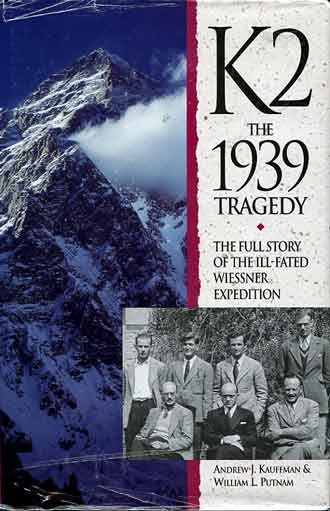
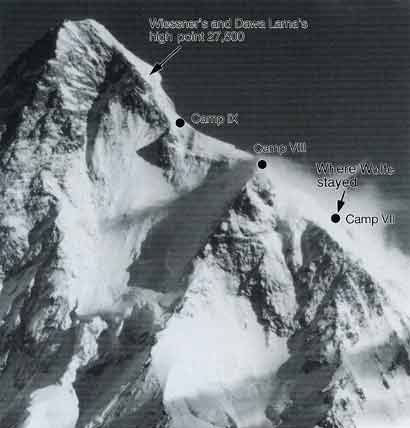
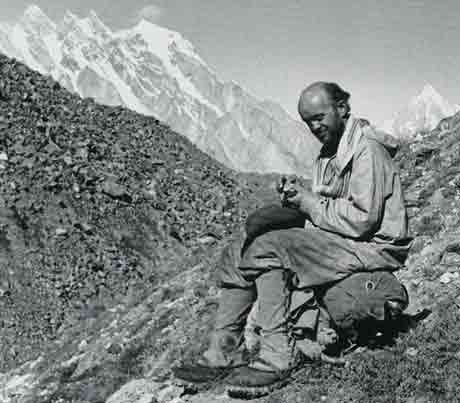

By Andrew J. Kaufman and William L. Putnam. Published 1992. Using the recently available diary of Jack Durrance, the authors pieced together a thorough investigation into the 1939 American K2 Expedition where leader Fritz Wiessner and Pasang Lama came within 244m of the K2 Summit, but the expedition ended in tragedy when Dudley Wolfe and three Sherpas perished on the K2 Shoulder. There are 16 pages of bw photos, most by Jack Durance, 2 maps, 1 climbing route, and one sketch.
The book starts with picking the team and trekking to Base Camp, and setting up the mountain camps. As they climbed, "the expedition was split. Above at Camp VIII was Fritz Wiessner, strong and confident, with his equally dedicated and constant companion, Dudley Wolfe, their eyes hypnotized by the summit. Below was an exhausted band of men - Cranmer, Durrance, Sheldon, and Trench - under the command of a vacillating and irresolute leader, Cromwell."
Wiessner and Pasang Lama set out from Camp IX (7940m) on July 19, 1939 and by evening had reached 8367m, just 244 m from the summit with easy summit snows ahead. But, Pasang Lama did not want to go on, so they descended back to camp, losing their crampons on the way. They then descended to Camp VIII, picked up Dudley Wolfe, and continued to Camp VII, where "A great shock awaited them. The tents had been completely cleared.", with only a broken tent and some scattered food and fuel left. Earlier, the Sherpas, thinking that Wiessner and Pasang Lama had been killed by an avalanche, cleared as much of the camps as they could. Wiessner and Pasang left Wolfe at Camp VII, planning to descend and find the sleeping bags and other missing objects, and return. When they reached Camp VI, there were no provisions. "Staggering on to Camps V and IV they met with the same disappointment." They then had to descend all the way back to Base Camp, where Wiessner accused Cromwell of attempted murder. The accusations and counter-accusations had begun. Wiessner was too tired to climb, so four Sherpas volunteered to bring Wolfe down. They found Wolfe in a bad state and gone to pieces. Leaving one Sherpa behind, the other three went to bring Wolfe down, but "Four men vanished in the mists of K2. K2 had struck its last and deadliest blow."
The story of the 1939 K2 American expedition has all the hallmarks of a great novel, with intrigue, drama, personality clashes, and gripping mountain adventure. The appendix contains the 8-page report by the American Consol to India, Edward M. Groth, September 13, 1939, giving his balanced and sensible impressions of the events. The photos are good.
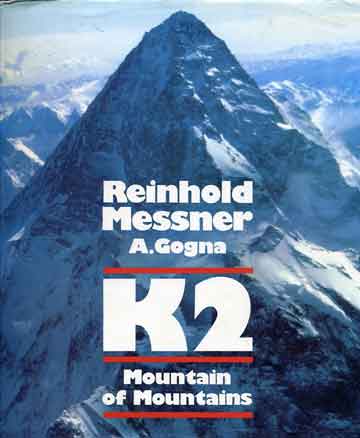
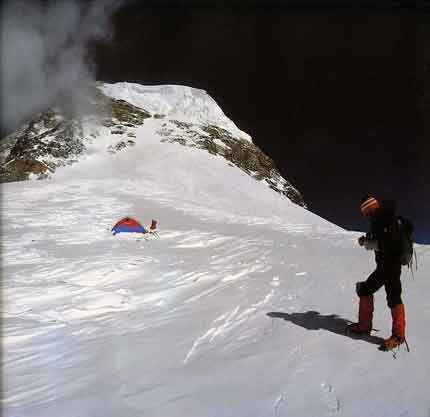
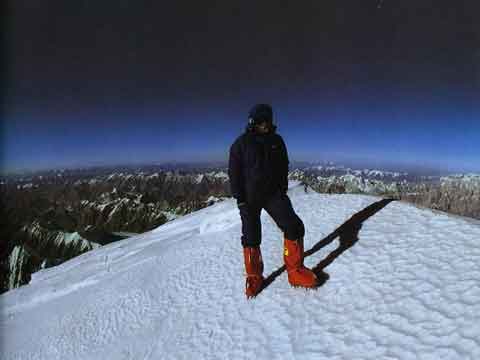
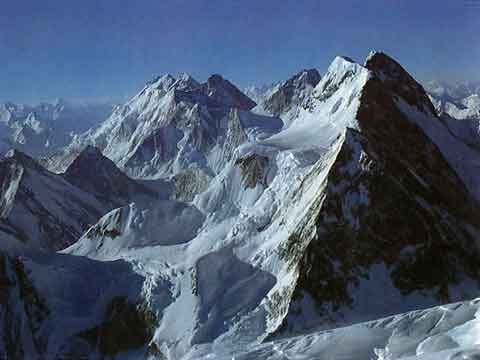
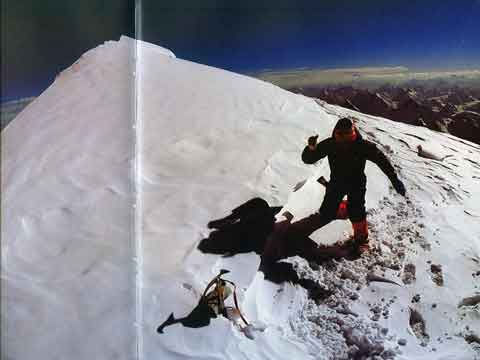

by Reinhold Messner and Alessandro Gogna. First published in English in 1981. This mainly photographic coffee-table type book tells the story of the ascent of K2 by Reinhold Messner and Michl Dacher on July 12 1979. Two chapters were written by Gogna, one by Messner of his ascent, and one of the history of K2. The cover is an aerial view of the K2 West Face taken by Dianne Roberts from the 1975 American Expedition. There are 96 pages of colour photos, 4 pages of b/w photos, 26 b/w photos in-line with text, 1 drawing, 4 maps, 5 photos with climbing routes.
Messner made all the plans for the K2 expedition, supplied most of the money, and chose the team of Michl Dacher, Sandro Gogna, Friedl Mutschlechner, Robert Schauer, and Renato Casarotto. After briefly attempting what Messner called the Magic Line, the South-South-West Ridge, he switched to the normal Abruzzi Route. Messner and Dachl seized a spell of good weather and climbed from Base Camp (4950m) to Camp 1 (6100m) on July 8. On July 9 they climbed to Camp 2 (6700m), July 10 to Camp 3 (7350m), and July 11 to 7910m.
On July 12 Messner and Dacher climbed up the Bottleneck and the K2 summit slope. "The snow slope ahead stretches out endlessly. ... When I move, it is the movement of an animal; when I rest, I am a rock. ... This hasn’t got much to do with climbing anymore. It’s more a matter of endurance, holding out, suffering a torture beyond pain and exhaustion."
"Suddenly, I’m standing in the sun, and know at once that we’re on the summit. ... The view is clear in all directions, for nearly 200 miles. An air of happiness hangs over everything. This is the most beautiful panorama I have ever seen!"
The photos are excellent. Gogna's writing is straightforward. Messner's writing is interesting and poetic, letting us know his feelings and inner-most thoughts.
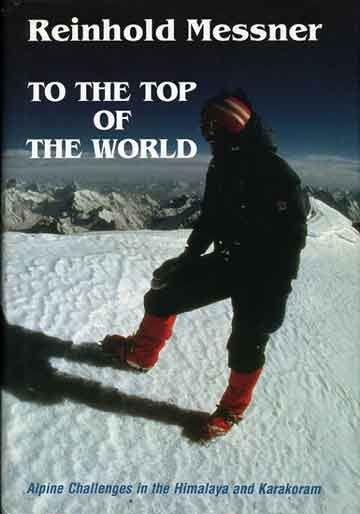
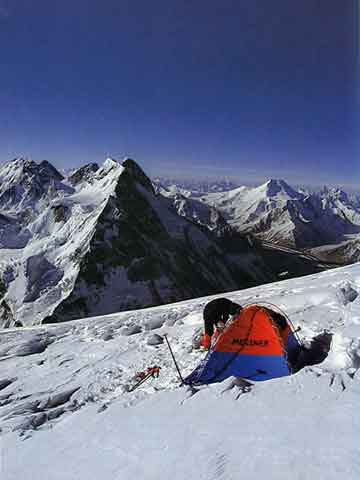
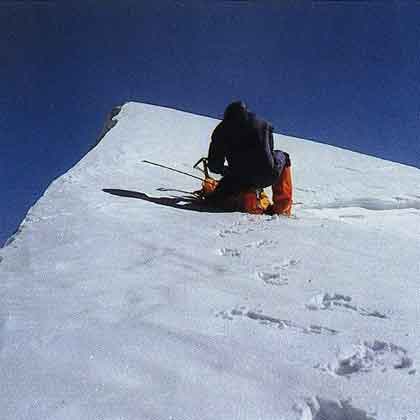

by Reinhold Messner. Published in English in 1992. The book briefly describes Messner's ascents of Manaslu in 1972, Gasherbrum I (Hidden Peak) in 1975, Everest without oxygen in 1978 and solo in 1980, Nanga Parbat solo in 1978, K2 in 1979, and a traverse of Gasherbrum I and II in 1984. There are 56 pages of colour photos, 20 pages of b/w photos, 26 b/w photos, and six paintings by French artist Jean-George Inca highlighting the stories in the book.
The 16-page chapter on K2 tells the story of the ascent of K2 by Reinhold Messner and Michl Dacher on July 12 1979. There are 8 pages of colour photos, 3 pages of b/w photos, 2 b/w photos in-line with text, and 1 climbing route.
"Our movement had become an irregular crawling. The snow slope in front of us grew endlessly. ... It was in parts as steep as a church roof and lower down the face fell away vertically. I knew that we had no chance of surviving if one of us slipped."
"Suddenly I was standing in the sun and simultaneously I knew that we had reached the summit. ‘We’re there. We’re on top.’ ... The panorama was clear in all directions for a distance of 300km. Over everything lay a breath of cheerfulness: the most beautiful panorama I had ever seen!"
The photos are excellent. The translation is a bit awkward compared to the original in the Mountain of Mountains book. Messner's writing is interesting and poetic, letting us know his feelings and inner-most thoughts.
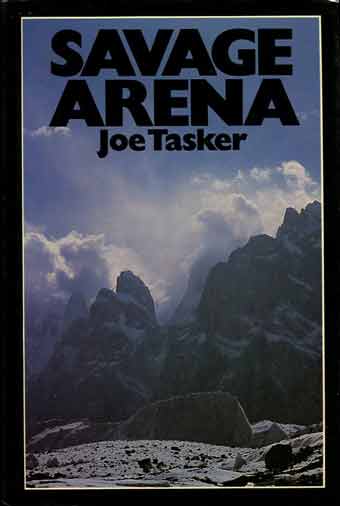
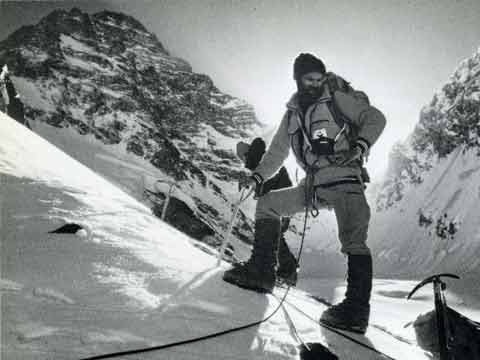
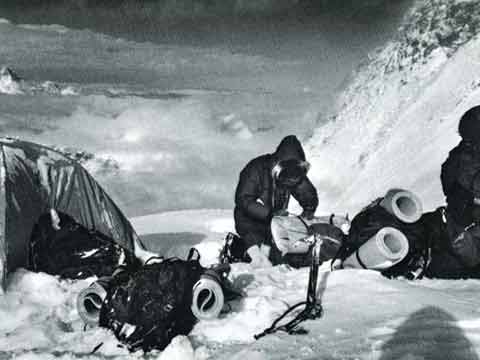

by Joe Tasker. Published 1982. One of Michael Chessler's Top 100 Mountaineering Books. Also available in The Boardman Tasker Omnibus. This book describes Tasker's climbs on the Eiger (1975, 20 pages, 3 pages of b/w photos), Dunagiri (1965, 51 pages, 5 pages of b/w photos), Changabang (1976, 36 pages, 4 pages of b/w photos), K2 (1978 and 1980, 77 pages, 8 pages of b/w photos), and Kangchenjunga (1979, 55 pages, 4 pages of b/w photos).
In 1978 Chris Bonington led an attempt on the then unclimbed K2 West Ridge. "[K2] was colossal, a symmetrical pyramid, so vast that we could only gaze on it with faith that somewhere in all that mass were the lines of weakness which would enable us to reach the top." But the expedition ended early when tragedy struck. "I heard vaguely the roar of an avalanche. ... below me I saw the slope beyond our tent sliding away in a billowing column of cloud. Where I had last seen two figures there was now only one." Nick Estcourt was killed in the avalanche. Doug Scott escaped when the rope to Nick snapped.
Joe Tasker, Pete Boardman and Doug Scott returned in 1980 with Dick Renshaw, but failed again on the West Ridge. Joe, Pete and Dick then tried the normal Abruzzi route. After reaching their high camp at 8070m, there was a heavy snow fall. "I woke to an instant awareness of the imminence of a sordid death. All was black, the tent was collapsed on us. A heavy avalanche of snow was pouring over the tent. ... It was a brutal and implacable force of nature with no malice." After surviving the avalanche, it took three harrowing days to descend down the mountain. After recuperating at base camp, they gave it another try, but again were stopped by bad weather.
I enjoyed reading Joe's mountaineering adventures. The photos are good. Pete Boardman and Joe Tasker disappeared in March 1982 climbing the North East Ridge of Everest. The Boardman Tasker Prize for Mountain Literature was established in their memory.

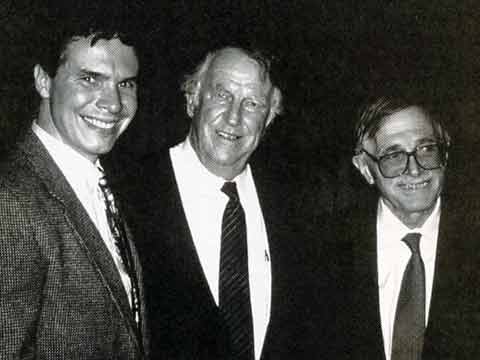
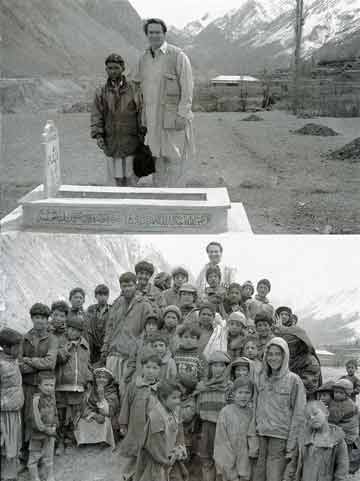

by Greg Mortenson and David Relin. First published 2006. This is the fascinating story of Greg Mortenson's dedication to building schools in the Northern areas of Pakistan, and founding the Central Asia Institute. There are 16 pages of bw photos and two maps.
After failing to climb K2 in 1993, an emaciated Mortenson got lost on the return trek, and stumbled into the small village of Korphe, where the village leader, Haji Ali, slowly helped nurse him back to health. When he watched the local schoolchildren trying to learn in the open, "I felt like my heart was being torn out. There was a fierceness in their desire to learn ... I knew I had to do something. ... I will build a school ... I promise"
Mortenson struggled to make enough money to return to Pakistan, finally finding a rich donor, Jean Hoerni, who helped him found the Central Asia Institute. He first had to build a bridge over the river, and then in late 1996 the Korphe school was finished. "Haji Ali taught me to share three cups of tea, to slow down and make building relationships as important as building projects."
Mortenson knew that other villages also needed schools, so he continued fund raising and building schools for both boys and girls in this Muslim country, with the support of the Muslim clerics. Mortenson's work has become even more important in the post 9/11 era. "What's the difference between them becoming a productive loyal citizen or a terrorist? I think the key is education."
Mortenson comes across a bit naive at times, putting himself in dangerous situations, surviving an eight day armed kidnapping near Peshawar, and escaping a firefight with feuding Afghan warlords. Relin comes across as worshiping Mortenson's career, and possibly could have been more objective.
This is a truly inspiring story of dedication, perseverance and compassion. It is also a very enjoyable adventure story.
My favourite books that partially feature K2 are:
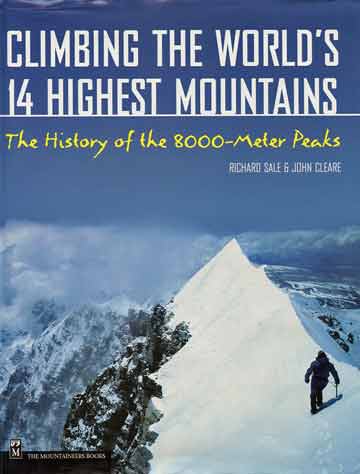
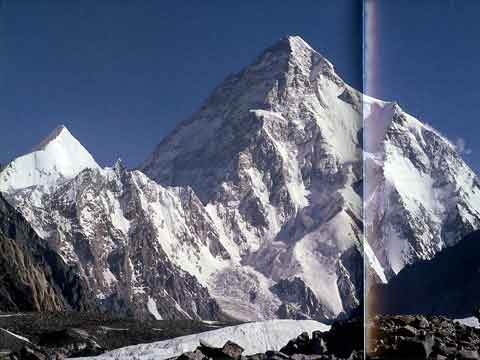

by Richard Sale, John Cleare (Photographer) - Highly recommended! The book details the exploration, first ascent, and other major ascents of all 14 8000m peaks, including spectacular photos.
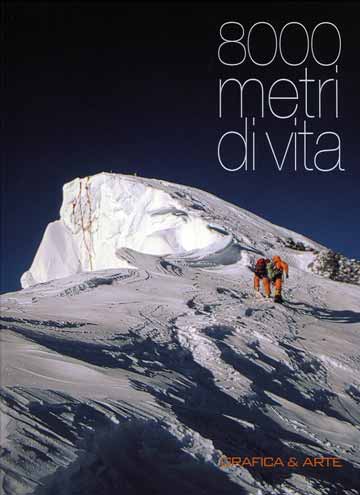
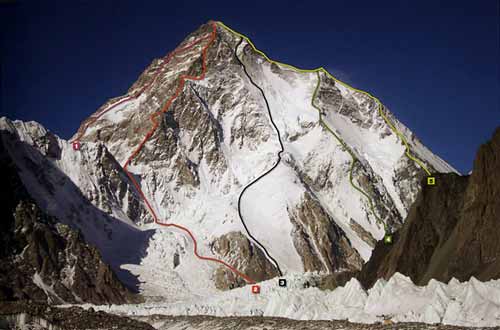
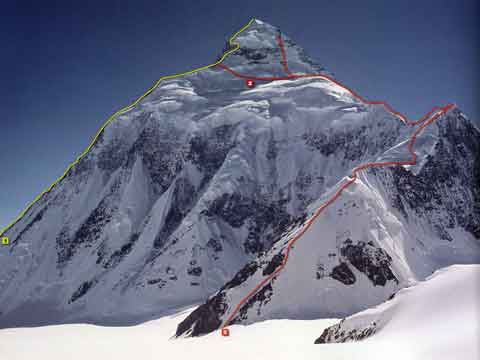
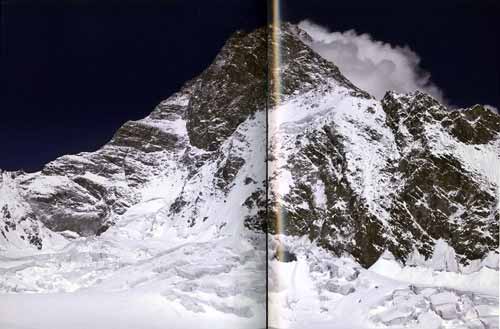

by Simone Moro. Published 2008. In Italian and English. This coffee-table size book features excellent photos from all 14 8000m peaks. Each 8000m peak has a brief history, a photo of each face showing the climbing routes, and lots of excellent photos.
There are 12 pages on K2. Simone Moro's attempt on K2 in 2003 ended at the Bottleneck due to bad weather.
The photos and route diagrams are excellent.
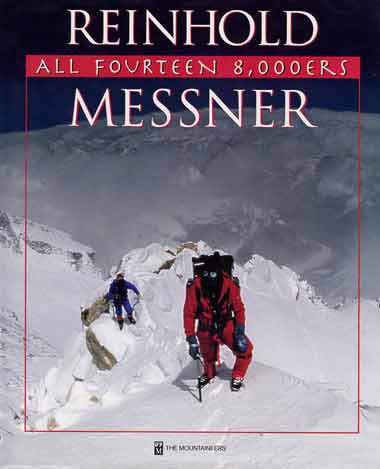
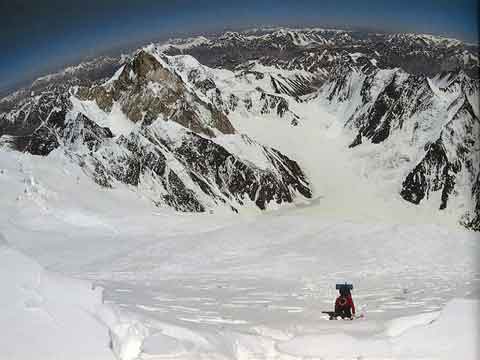
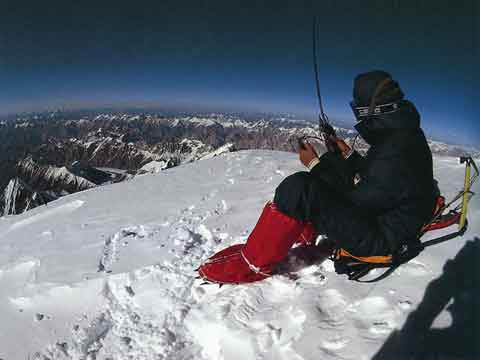

by Reinhold Messner. One of Michael Chessler's Top 100 Mountaineering Books. This book details Messner's ascents of all 14 8000m peaks documented with his photos. He also includes route diagrams and some basic history of the first few ascents. Messner was the first climber to summit all 14 mountains over 8000 metres in height, beginning with Nanga Parbat on June 27, 1970 and finishing with Lhotse on October 16, 1986.
After abandoning his so-called Magic Line on the south spur, on July 12, 1979 Reinhold Messner and Michl Dacher completed the fourth ascent of K2 by the Abruzzi Ridge. K2 was Messner's 5th 8000er.
The photos are very good, the story straightforward.
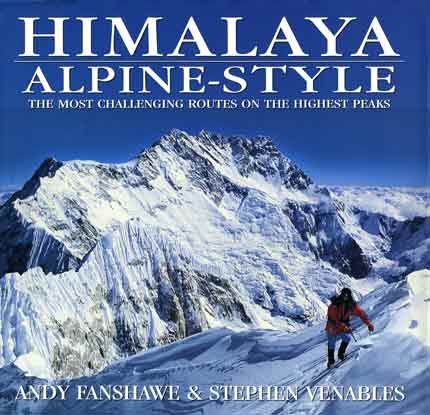
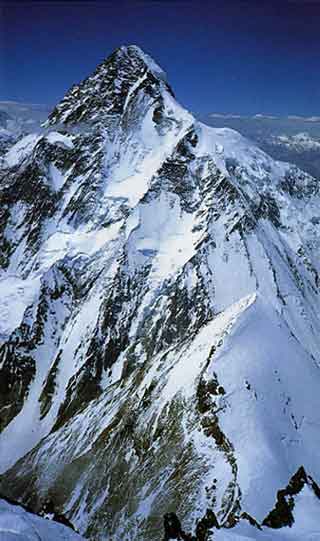
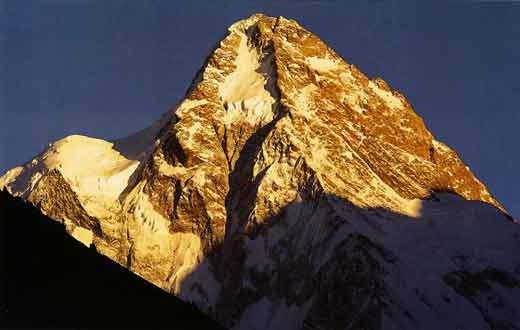

by Andy Fanshawe, Stephen Venables. Published 1996. This book briefly details 40 of the world's finest climbs on mountains in Pakistan (including Broad Peak, K2 and Nanga Parbat), India, Nepal and Tibet (including Annapurna, Shishapangma, Cho Oyu, Everest, Makalu and Kangchenjunga). Each climb is illustrated with many great photos, climbing routes, and summary statistics and information. Each area has an excellent overview map.
There are four pages on K2 Southeast Abruzzi Spur and four pages on K2 North Ridge.
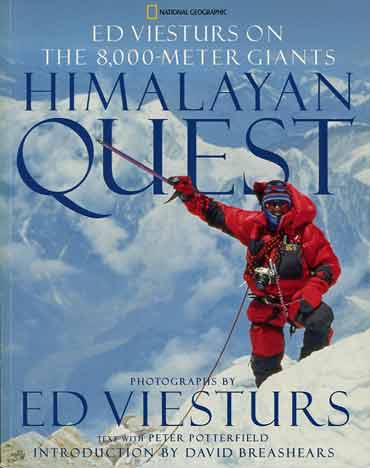
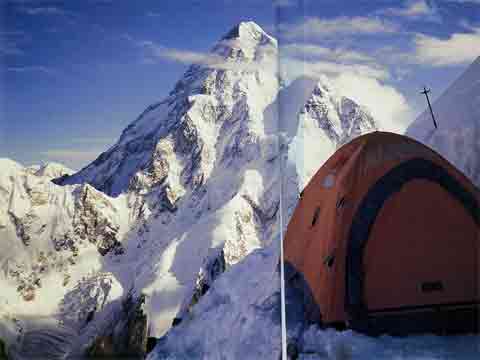
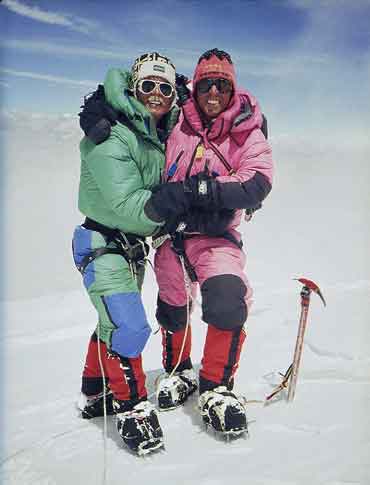

photographs by Ed Viesturs, text with Peter Potterfield. Released in early 2003, this book presents photographs with some basic text descriptions of Viesturs' ascents of 11 of the 14 8000ers. After this book was published he reached the summit of Nanga Parbat in June 2003, Broad Peak in July 2003, and on May 12, 2005 he reached the summit of Annapurna, becoming the first American to reach the summit of all 14 8000ers, all without oxygen.
Viesturs devotes 59 pages to his attempts on Everest in 1987, 1988 East Kangshung Face, 1993 and 1995, and his successful summits in 1990, 1991, 1994, 1996, and 1997. Ed was part of the 1996 Everest IMAX movie, and on his own way to the summit he had to pass the bodies of Scott Fischer and Rob Hall who had died days before. "I had never had a friend die, let alone a climbing partner. So seeing my friends' bodies was very difficult."
Ed's photos are excellent.
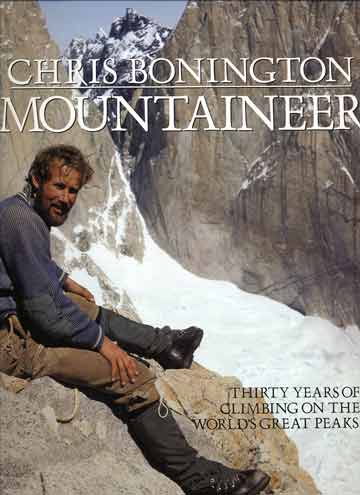
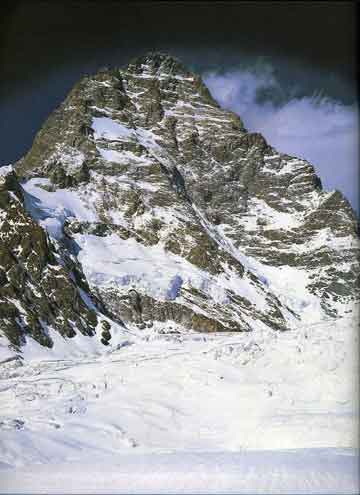
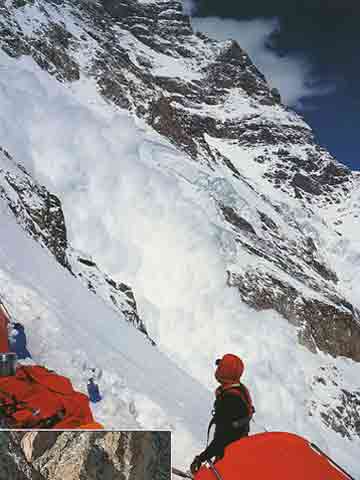

by Chris Bonington. First published 1989. One of Michael Chessler's Best Mountain Photo Books. Famed British mountaineer Chris Bonington tells his autobiography mostly in photos in this coffee-table type book. The book features his early climbs in Great Britain; his alpine climbs in the Alps including Mont Blanc, the Eiger and Grandes Jorasses; his expeditions around the world including Paine in Chile, Baffin Island and the Blue Nile; and his expeditions both large and small to the Himalayas and the Karakorum - Annapurna II, Nuptse, Annapurna I South Face, Everest Southwest Face, Everest Northeast Ridge, the Ogre, K2, and Menlungtse.
Bonington devotes four pages to the K2 West Ridge attempt in 1978. After his success on the Southwest face of Everest in 1975, Bonington led an expedition to attempt the K2 West Ridge in 1978. Nick Estcourt died on June 11, 1978 in an avalanche. "The only trace of the avalanche was the cone of snow at the bottom of the hanging glacier, but that had been there before. It didn’t seem any bigger, yet thousands of tons of snow and ice must have poured down, sweeping Nick [Estcourt] with them."
Bonington's photos are excellent.
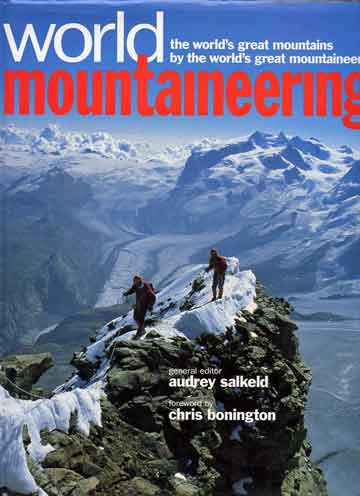
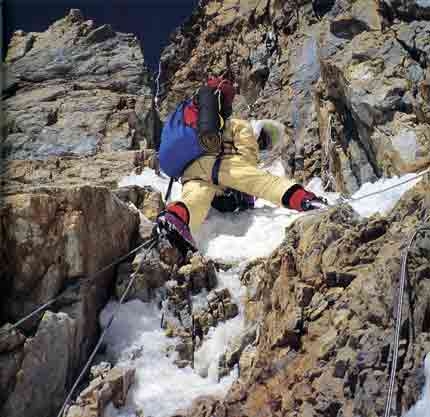
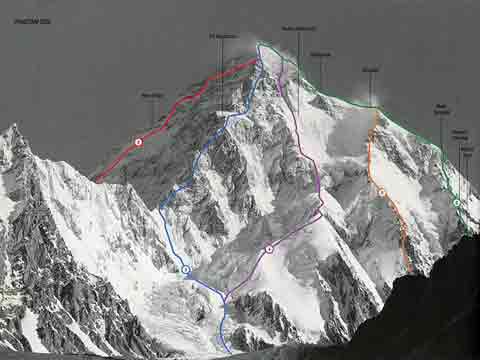

by Audrey Salkeld. Published 1998. The book briefly details 52 of the world's finest climbs from Europe (including Mont Blanc, the Matterhorn and the Eiger), Arctic and North America, South America, Antarctica, Indonesia and Oceania, High Asia and Korea and Japan (including K2, Nanga Parbat, Kangchenjunga, Mount Everest), and Africa. Each climb is documented with photos, excellent aerial-type maps, and a basic climbing history.
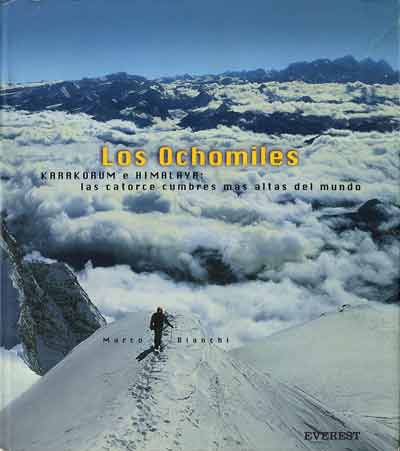
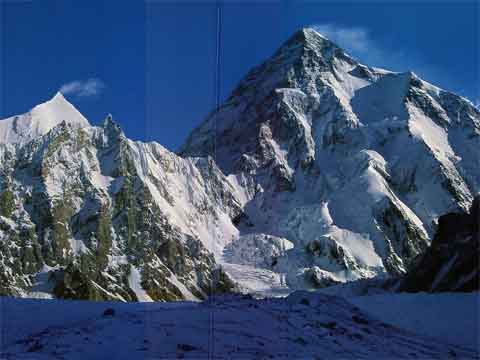
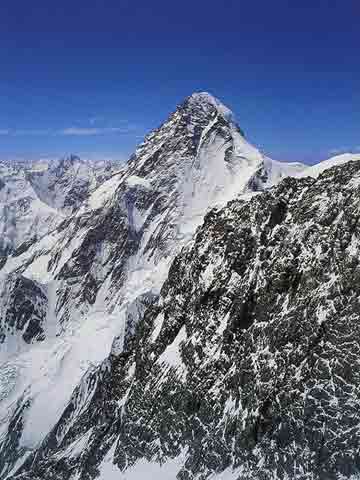
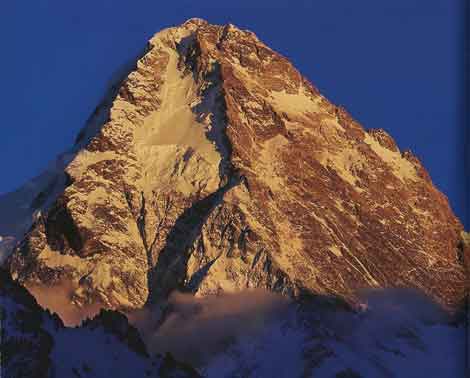

by Marco Bianchi. Published 2003. Although the title claims to be the 14 highest summits in the world, this beautiful, large-format photo book really focuses on the seven mountains the author climbed. The text is in Spanish, but the photos transcend language.
After attempts on Makalu in 1986 and Cho Oyu in 1989, Bianchi summited seven of the 14 8000m peaks: Manaslu Sept. 28 1992 via Northeast Face, Broad Peak July 6 1993 via Normal route, Cho Oyu Sept. 18 1993 via West Ridge, Shishapangma Oct. 6 1993 via Southwest Face, Dhaulagiri Sept. 25 1994 via Northeast Ridge, Everest May 12 1995 via Northeast Ridge, and K2 Aug. 10 1996 via North Ridge.
There are 44 pages of the trip from Islamabad to Skardu, the trek up the Baltoro Glacier to Concordia, Gasherbrum I and II, Broad Peak and K2.
There are 16 pages of the trek to K2 North Face and his climb of the K2 North Ridge with Krzysztof Wielicki and Christian Kuntner.
The photos are excellent. You can preview many of the photos at marcobianchifotografo.com.
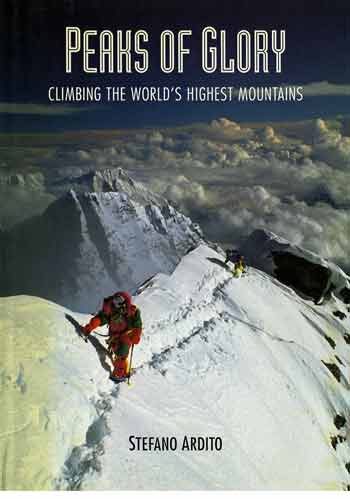
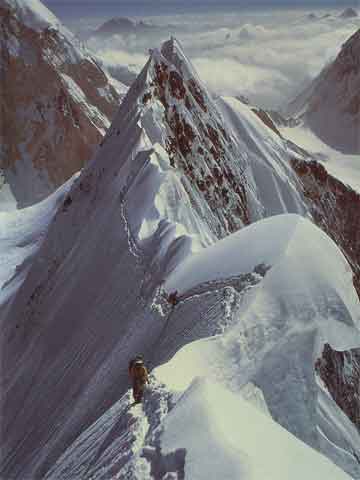
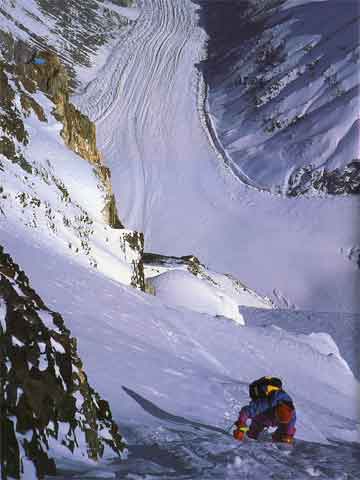

by Stefano Ardito. Published 1993. This is a large coffee-table style book with excellent photos, briefly listing the most challenging mountains on each continent, including Everest, Annapurna, Nanga Parbat, K2 and the Trango Towers in the Himalaya, and K2, Denali and Aconcagua, and Mont Blanc and the Matterhorn.
There are 15 pages on K2.
The photos are very good.

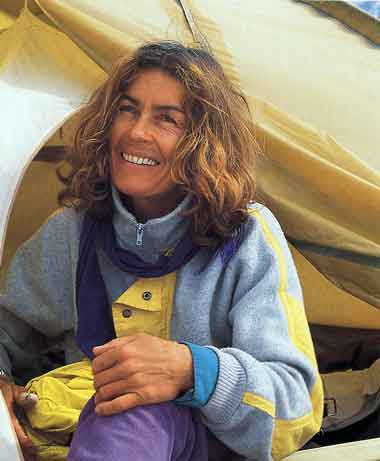
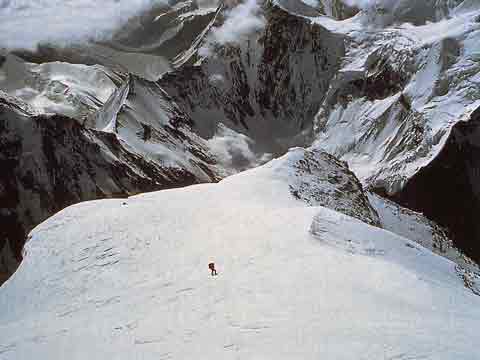
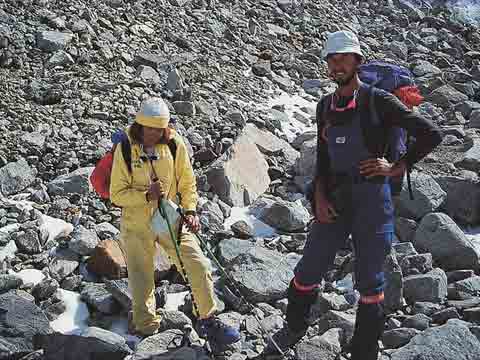

by Gertrude Reinisch. Published in English in 2000. This book traces the career of Polish climber Wanda Rutkiewicz. It includes brief reports of Trollryggen in Norway in 1968, Pik Lenin 1970, the Eiger North Face 1973, the Matterhorn North Face 1978, Aconcagua South Face 1985, and Cerro Torre 1988. The book focuses mainly on her climbs in the Himalaya and Karakoram, including: the first ascent of the then highest unclimbed peak 7952m Gasherbrum III August 11, 1975 (4 pages); Mount Everest summit October 16, 1978 (10 pages); Nanga Parbat attempt 1976 and summit July 15, 1985 (5 pages); K2 expedition leader 1982, attempt 1984, and becoming the first female to summit K2 June 23, 1986 (35 pages); Makalu attempts 1986 and 1990 (10 pages); Shishapangma Main Summit September 18, 1987 (4 pages); Gasherbrum II summit July 12, 1989 (14 pages); Gasherbrum I summit July 16, 1990 (19 pages); Cho Oyu summit September 26, 1991 solo (2 pages); Annapurna winter attempt 1987 and south face summit October 22, 1991 solo (15 pages); Dhaulagiri aborted attempt 1991 (3 pages); Yalung Kang (8505m) winter 1988/89 attempt, and Kangchenjunga attempts in 1991 and 1992 (24 pages); Wanda Rutkiewicz died May 12 or 13, 1992 on Kangchenjunga. There are transcripts of many of her personal letters from expeditions across the world. There are many photos.
Wanda climbed with Lilianne and Maurice Barrard and Michel Parmentier on K2 in 1986. 'After an icy night at 7900m, four in a single tent without sleeping bags ... Wanda and her companions somehow put the Bottleneck and the ice traverse behind them, but then found themselves in chest-high snow, with no choice but to spend a second night in the Death Zone [at 8300m]. The final stretch to the summit lay over a long shoulder which, in their state of exhaustion on that icy cold morning of 23 June 1986, seemed endless.' ... [Wanda] 'Climbing on alone was really exciting, and I was thrilled to be so near the summit, etched like a crown with three points. It was a beautiful day. My dreams of reaching the second-highest peak in the world - so much more beautiful than Everest - was coming true and the weather couldn't have been more perfect for the occasion. When I stood alone on the very top it was 10:15. Around me lay a stupendous ring of slightly lower mountains. Clouds hung in the valleys below, and above was nothing but the infinite expanse of sky. ... I felt no triumph, but I did feel that God was near me. I've always felt close to God at the top of different mountains.' Wanda was the first Pole and the first woman to scale K2, and she stood there alone, savouring the taste of success. Wanda was followed by Lilianne and Maurice and Michel.
They descended to their 8300m bivouac where Maurice suggested they stay the night. [Wanda] 'We made a big mistake. When you climb without oxygen, success depends on your speed and how long you spend in the Death Zone. It was a terrible night.' The next day, Michel descended quickly followed by Wanda with Lilianne and Maurice at the back. Michel fell down the Bottleneck, but landed on a snow drift and dusted himself off and continued down. Wanda reached their tent at 7700m after Michel, but there was no sign of Lilianne and Maurice. [Wanda] 'I asked myself whether there was any serious point in waiting any longer. It was mortally dangerous to stay on at that altitude.' Wanda continued her descent as a storm raged and made it back to their store camp at 7100m at the bottom of the Black Pyramid, where she waited for another two days hoping against hope. She then continued down to ABC where she met a rescue party who had more or less given up hope of seeing her alive again. Michel waited and waited for the Barrards, but he too finally had to descend. A few days later Lilianne Barrard's body was found on the lower glacier. [Wanda] 'I think Maurice and Lilianne must have lost the route in the bad visibility and either fallen or been taken by surprise by an avalanche.'
The book is written in a straightforward manner, factual and to the point. The chapter on K2 is very good describing her dangerous descent. We do get some insights into Wanda as a person through her relationship with the author and her letters. The photos are very good.
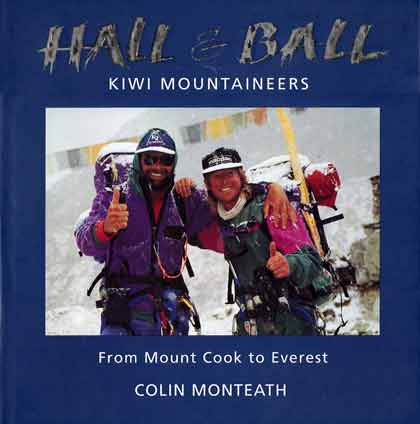
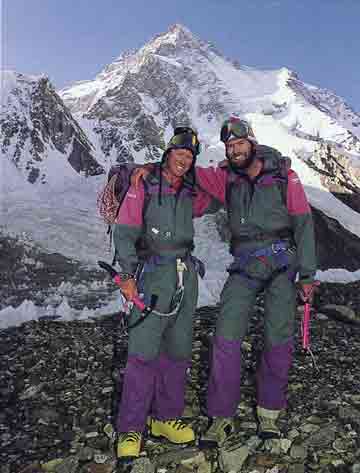
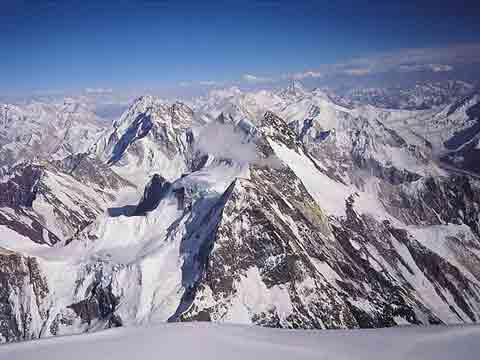

by Colin Monteath. Published 1997. This book details the climbing adventures of fellow-kiwis Gary Ball and Rob Hall. In addition to the big climbs on Everest, K2, Dhaulagiri, Lhotse, Cho Oyu, and Makalu, the book also profiles their climbs on Mount Cook, Antarctica, Pik Kommunizma, and Ama Dablam. After their first ascent on Everest they climbed the 7 summits in only 7 months. Hall and Ball will be remembered for pioneering commercial guided expeditions, with their Adventure Consultants company leading 39 climbers to the top of Everest from 1990 to 1995.
The section on K2 is 12 pages. Rob and Gary Ball failed in attempts in 1988 and 1991. In 1992, Gary collapsed at 8300m felled by another bout of altitude sickness, and had to be dragged down the mountain. Rob Hall finally reached the summit of K2 on July 9, 1994.
Rob's description of K2: "When God was designing mountains he did a particularly good job on Chogori (K2) as there is no easy approach to the summit. All sides are steep and inhospitable. The rock is soft and the faces support huge snowfields, which can unleash the most spectacular avalanches ... its geographical position acts as a magnet for bad weather."
The photos are excellent.
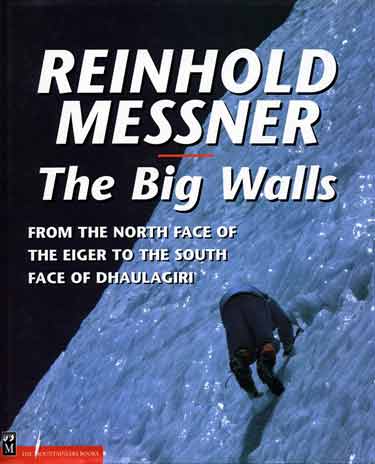
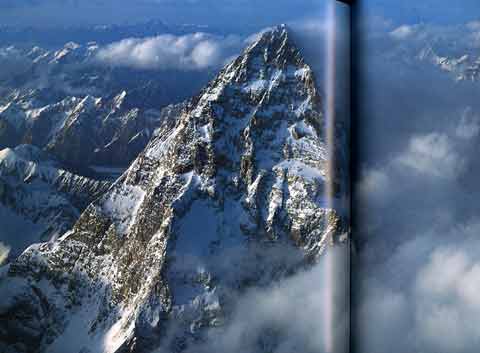
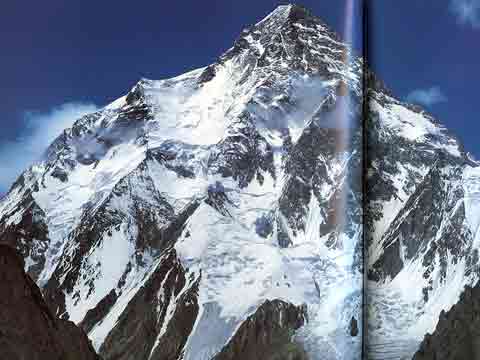

by Reinhold Messner. Revised in 2001. Messner briefly details the big mountain walls in the world in the Himalayas, the Karakorum, the Alps, South America, Alaska and the Caucasus.
It includes two pages on climbing K2 West Face, and two pages on K2 South Face Kukuczka Route.
I like this as a reference book. The photos are very good.
K2 is also featured in many travel photo books. Here are my favourites:
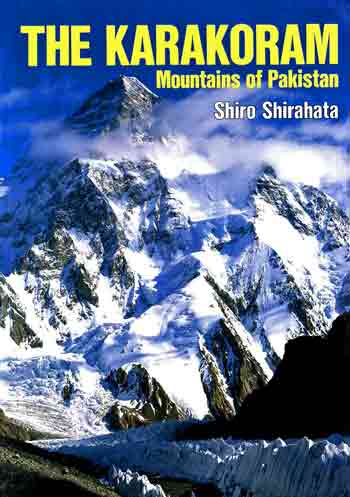
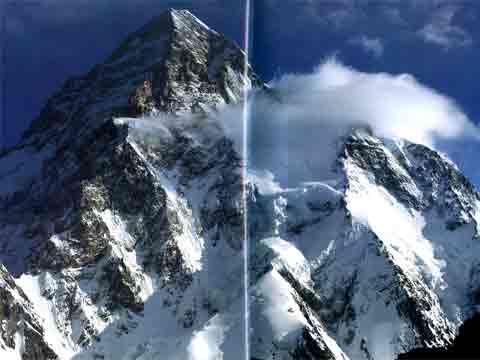
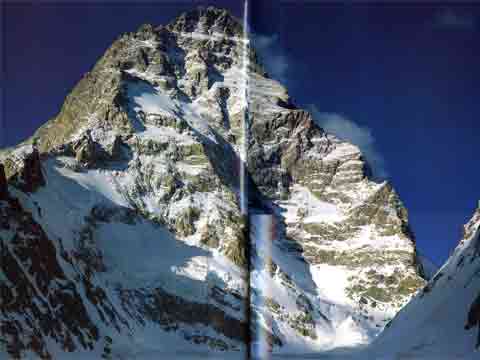

by Shiro Shirahata. Published 1990. One of Michael Chessler's Best Mountain Photo Books. He may just be the best mountaineering photographer ever. This coffee-table sized book provides stunning large photographs printed on glossy quality paper.
This book contains K2 (cover), Broad Peak, Gasherbrum I, Gasherbrum II, Gasherbrum IV, Chogolisa, Nanga Parbat, and Tirich Mir. The photo of Gasherbrum IV on the back cover is stunning.
The photos are excellent. Shirahata just may be the best mountaineering photographer ever.
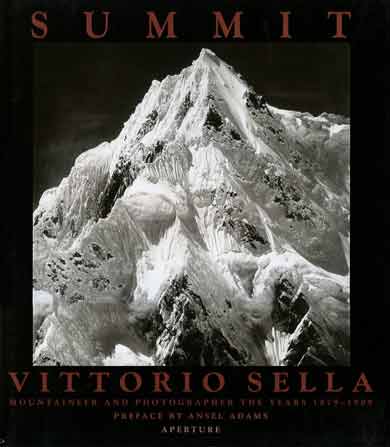
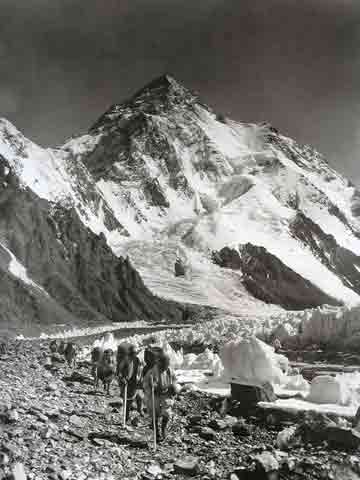
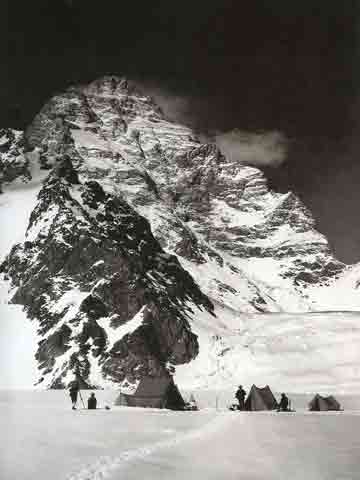
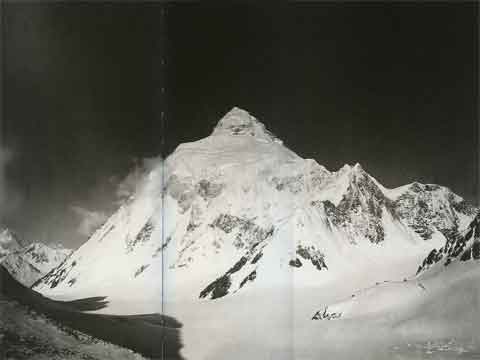
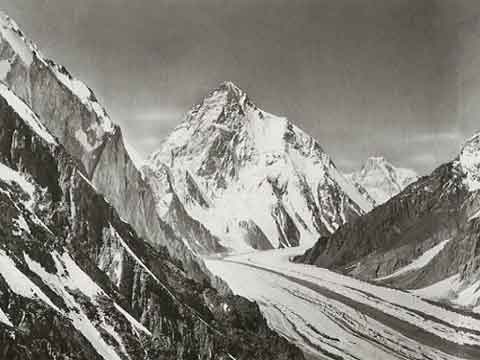

by Vittorio Sella. Spectacular b/w photos in a coffee table sized book. The chapters are the Alps, the Caucasus in Russia (includes a 4-page fold-out panorama from Elbrus), Mount Saint Elias in Alaska, Ruwenzori in Uganda, K2 and area (includes a 4-page fold-out panorama of K2, Broad Peak, Gasherbrum IV, Chogolisa, Mitre Peak).
The book includes 30 pages on K2, Broad Peak, Gasherbrum IV, Chogolisa, Mitre Peak, Muztagh Tower. and Masherbrum.
The photos are spectacular.
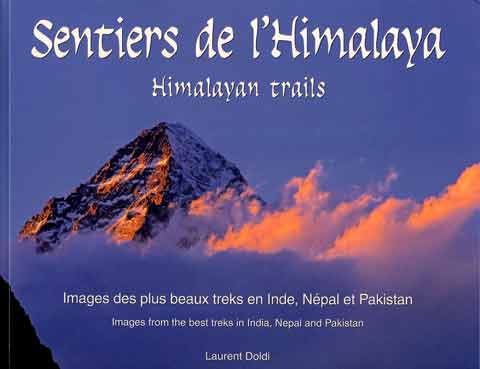
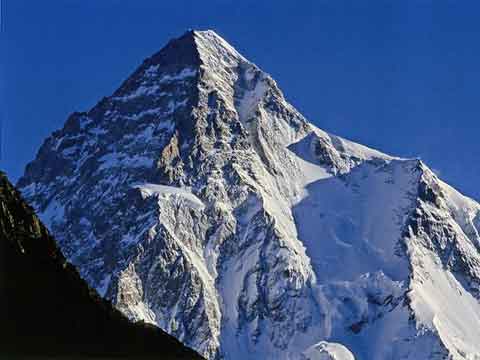
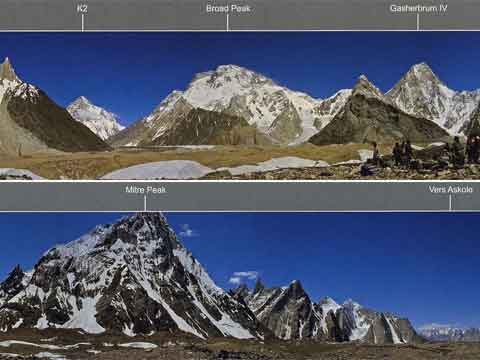

by Laurent Doldi. Published 2006. In French and English. A large soft-cover photo book detailing 10 Himalayan treks: K2 Base Camp (12 pages. 23 photos), Ladakh to Zanskar (16 pages, 38 photos), Jeep tour in Kinnaur Spiti and Ladakh (12 pages, 32 photos), the Sources of the Ganges in India (14 pages, 30 photos), Dolpo (18 pages, 36 photos), Around Annapurna (22 pages, 45 photos), Helambu and the sacred lakes of Gosainkund (16 pages, 29 photos), Rolwaling Valley in winter (18 pages, 37 photos), Everest Base Camp and Gokyo Lakes (20 pages, 41 photos), and Kangchenjunga Base Camps in Nepal (21 pages, 44 photos). Each chapter starts with a very brief overview including a map and altitude profile. The front cover is K2. There are 360 colour photos.
This is very good companion book to a trekking guide, enabling you to visualize what you will experience on a trek. The photos are very good.
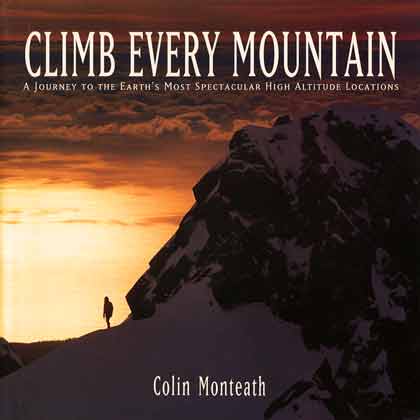
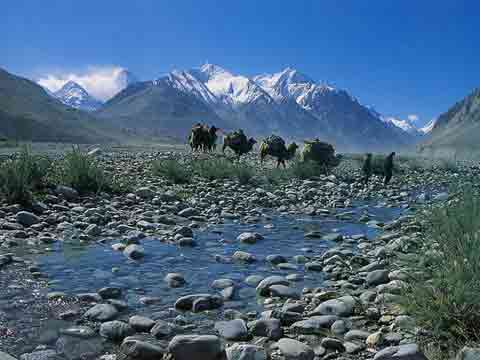
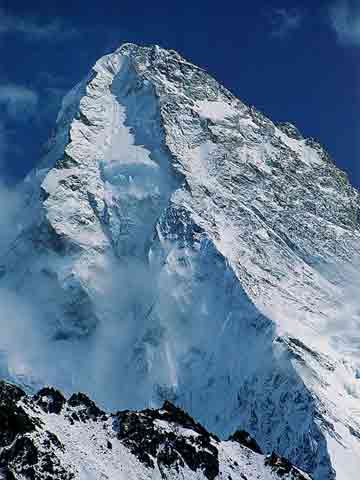

by Colin Monteath. Published 2006. Details 12 of Colin's treks over the years - Greenland, climbing Chongtar near K2 North Face, New Zealand Alps, Everest Kangshung East Face, Mount Kailash and Gurla Mandhata, northern Bhutan. Mongolia's Altai mountains, South Georgia on Shackleton's route, Tibet's Kangri Garpo mountain, ski traverse of Mount McKinley, Nepalese side of Kangchenjunga, and Tiera del Fuego and Patagonia.
There is a 22-page chapter on the trek from Kashkar to attempt the unclimbed three summits of Chongtar, near K2 North Face, in August 1994. Colin Monteath, Lucas Trihey, and Greg Mortimer climbed the north peak (7250m), with Greg continuing on to climb the Chongtar main summit (7350m), but extreme cold and high winds pushed Greg back from the south summit (7180m)
Greg's photos are excellent.
For news on K2 expeditions, I check the following regularly:
There are a few informational K2 websites, with my favourites being:
K2 expedition photo galleries:
I thoroughly enjoy reading other people's travelogues and looking through their photos. Here are my favourites on Mustang:
In addition to the following DVDs and Videos please see youtube.com and vimio.com K2 videos.
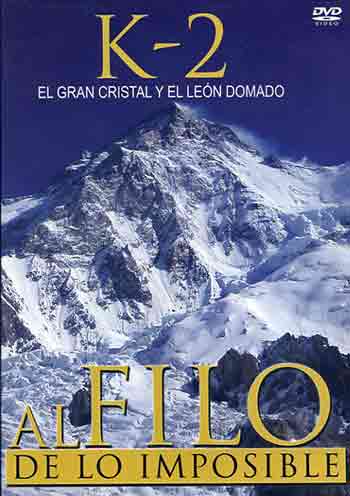
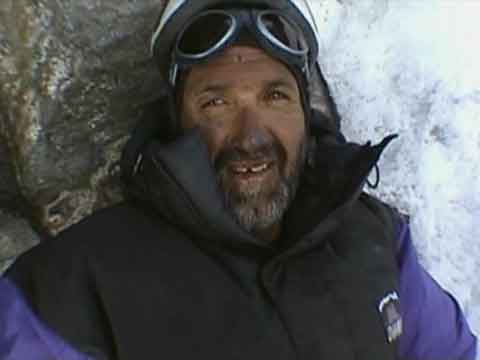
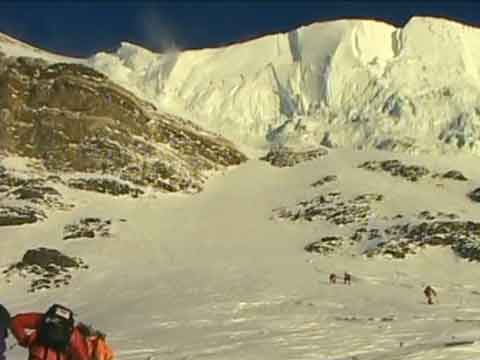
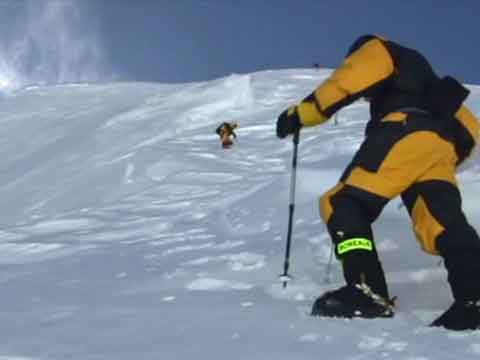
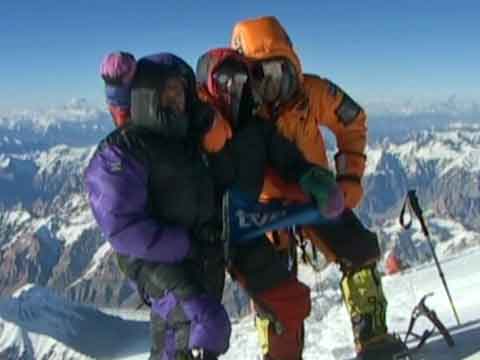

by Sebastian Alvaro. Al Filo De Lo Imposible, Spanish TV. 107 minutes. Filmed in 2004. Released 2005. This film documents the 2004 Spanish K2 Expedition from beginning to end, following Spanish climbers Juanito Oiarzabal, Edurne Pasaban, Juan Vallejo, and Mikel Zabalza as they climb K2 on the 50th anniversary of the first K2 ascent.
The film opens in the night with a distraught Alvaro at base camp talking to a high camp, who are explaining that after reaching the summit earlier in the day, Juanito Oiarzabal is lost and hasn't reached Camp 4, and asking the Italians for help to find him. They found Juanito semi-unconscious and helped him to Camp 4. An exhausted and utterly shattered Juanito struggles to come down the fixed ropes as Alvaro implores him to keep moving. Edurne Pasaban and finally Juanito arrive at Base Camp (they were airlifted out of Base Camp by helicopter, and eventually lost toes to frostbite). Phew! What an opening!
The expedition starts with the climbers driving to Askole in jeeps, the porters carrying to Base Camp, walking up the glacier, and climbing the Abruzzi Ridge to Camp 1 and digging out space for the tents. Back at Base Camp, Juanito prepares dinner and there is singing and dancing. There is a meeting between Kari Kobler of the 2004 Italian team and the other expeditions talking about fixing ropes and using tents. We also see the Gilkey memorial with the many plaques added over the years. More climbing, up House's Chimney to Camp 2, once again digging out space for their tents, with his a dizzyingly long telephoto shot showing the precariousness of the camp. They climb higher to the Shoulder and set up Camp 3, and then descend in bad weather. Up they go again, climbing fixed ropes in bad weather to Camps 2 and 3, eventually setting up Camp 4 beneath the beautiful enormous serac. There are amazing mountain views of Broad Peak, the Gasherbrums and the Karakoram.
They set off for the K2 summit in the night in high wind and very cold weather. The fixed ropes are over, and they move slowly and carefully breaking trail on ice and then very deep snow. It is like time is standing still with only occasional movement from a climber. Edurne Pasaban, Juanito Oiarzabal (for the second time), Juan Vallejo, and Mikel Zabalza reached the summit of K2 on July 26, 2004 at 16.30 along side the first two Italians from the K2 50th anniversary team, Silvio Mondinelli and Karl Unterkircher. Base camp is jubilant when they learn that Juanito has made it. Juanito is welcomed by fellow climbers as he struggles to the summit. Juanito moves in extreme slow motion as he unfurls the TVA flag for the summit photo.
Interspersed with the 2004 expedition are footage from 1909; 1929 showing crossing rope bridges; 1954 expedition and summit footage and current interviews with Ardito Desio, Achille Compagnoni, and Walter Bonatti; brief footage and photos from 1986 and a current interview with Kurt Diemberger; and 1994 footage of the K2 North Ridge and current interviews with Juanjo San Sebastian and Ramon Portilla.
The filming is absolutely excellent, showing the beauty of K2 and surrounding mountains. We also get to see all of the K2 features like the Abruzzi Ridge, House's Chimney, the Shoulder, the enormous serac, and the summit headwall. They use close up, broad view, and extreme telephoto to give the depth and scale and steepness of the climb. The opening scene was gripping. I enjoyed seeing the old film footage and especially the interview with Diemberger. I thought the summit footage with Juanito moving in extreme slow motion to unfurl the TVA flag was very moving.
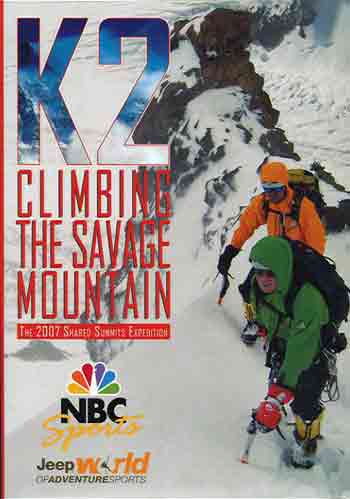
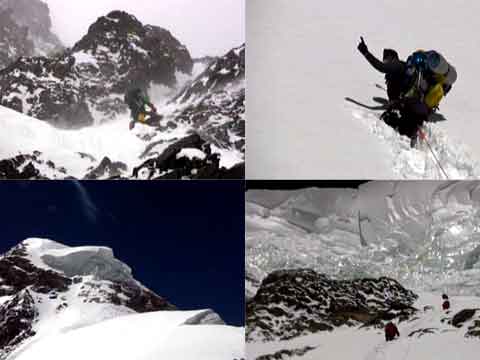
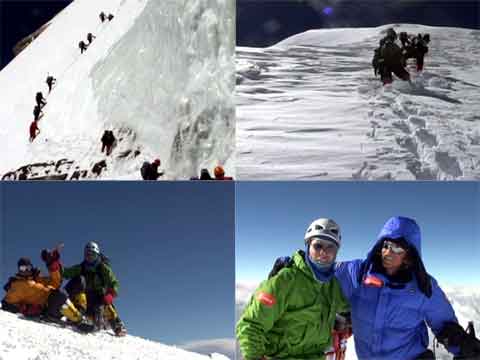

Filmed 2007. Released 2008. 44 minutes. The 2007 Shared Summits K2 Expedition, led by Chris Warner, was hosted on NBCSports.com and shown on NBC TV. The team switched to the Abruzzi Ridge after giving up on the East Face and Southeast Spur. Chris Warner, Bruce Normand and Don Bowie reached the Summit of K2 on July 20, 2007. The bonus is 6 minutes of interviews with Bruce, Chris, and Don.
There are a few quick scenes of the jeep ride to Askole and a few brief interviews. Kurt Diemberger: "K2 is the most difficult. It’s the most demanding. It is certainly one of the most dangerous 8000m peaks.” They trek to Base Camp and climb through the frightful ice fall to reach the East Face. Two hidden crevasses opened up with Chris falling into the smaller one. This was lucky because they probably would have been killed in the larger one. They attempt the East Face, setting up Camp I before they are stopped by the dizzying steep route with no place for a camp.
They return to Base Camp where they combine resources with the other expeditions to mount a unified international attempt on the Abruzzi Route. They start off a couple of times, making it to Camp 3 before being beaten back to Base Camp by the cold windy and snowy weather. They start again, go thru the icefall and climb in bad weather to camps I, II and III. Finally the weather improves, and the teams join together to break trail in the waist deep snow. They reach Camp 4 with excellent views of the Karakoram and the summit headwall. They continued climbing towards the summit, slowly crossing a very scary almost vertical ice face in their crampons. Eighteen people trudged up the deep snow to the summit.
This film graphically shows the many dangers and challenges of attempting K2, like the appalling bad weather, the icefall with huge seracs and crevasses, and the climbing. This film helps bring all the stories in the K2 books into focus. I enjoyed seeing mountaineering legend Kurt Diemberger being interviewed. There are a few annoying TV outros and intros.
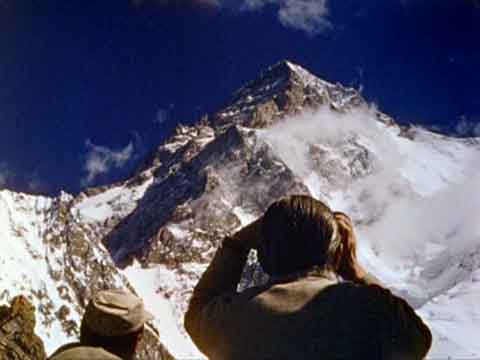
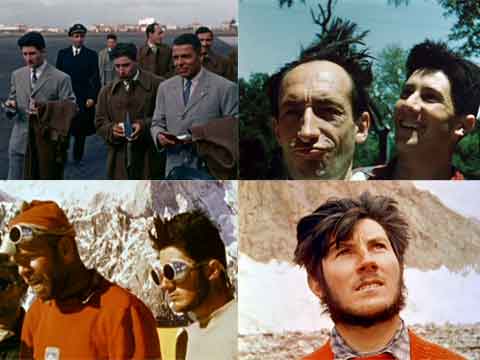
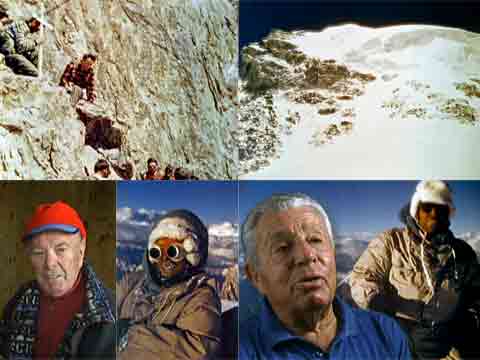

Directed by Alessandro Varchetta. Released 2004. In English. 49 minutes. This film was added to the German DVD of K2: Das letzte Abenteuer released in 2007. This film celebrates the 50th anniversary of the first ascent of K2 blending footage from the 1954 expedition with current interviews with expedition members, including Achille Compagnoni and Lino Lacedelli. There is also a brief re-enactments of Walter Bonatti's carrying oxygen up to Camp IX, which wasn't in the film.
Ardito Desio organized the expedition, but needed the Italian Prime Minister’s help to get the K2 permit, making it a state affair, a dream to unite post-war Italy. The film shows Desio lecturing the team in Italy, testing their equipment on the Matterhorn and Monte Rosa in winter, traveling to Rawalpindi, flying to Skardu and the porters carrying the supplies.
They set up base Camp and start setting up the camps and fixed ropes. Tragedy struck when Mario Puchoz died on June 21. We see a sad team bringing down his body and a small team ceremony next to his simple tombstone. They go up again in bad windy snowy weather, using a pulley system to bring supplies up to higher camps. Compagnoni comments on the weather: "We had 47 days of foul weather out of 70. It was like an affliction. We had to summon up enormous willpower to keep going." They set up Camp VIII (7700m) and got ready for the summit push.
The film deals openly with the team conflicts. Desio down at base camp had no idea what conditions were like 2000m further up. But that didn’t stop him from barking orders to the climbers in his usual military style. Bonatti and Mahdi would be the ones to carry the oxygen up to Compagnoni and Lacedelli at Camp IX, but they had moved Camp IX and Bonatti couldn't reach them. A near tragedy at the foot of the summit that night would bitterly divide the mountaineering world for 50 years. It would be an endless night; a mad struggle for survival. Lacedelli: "I have to admit that if it wasn’t for his (Bonatti's) help, we would never have got to the top."
As they near the summit Compagnoni films the Karakoram panorama from the Gasherbrums to Broad Peak and Chogolisa. They shoot film on the K2 summit of each other and the views. Compagnoni recalls his emotions on the summit: "I asked God to let me stay because it was, it was just too beautiful up there." Back in Italy the radio announced the good news. The whole of parliament applauded.
The colour in the 1953-54 footage is vibrant. I especially liked seeing the climbers in Italy dressed nicely in suits. It was wonderful to see the youthful and playful Walter Bonatti goofing around on the ship, in a Rawalpindi pool and anxiously waiting for mail. The film near the summit and on the summit is excellent.
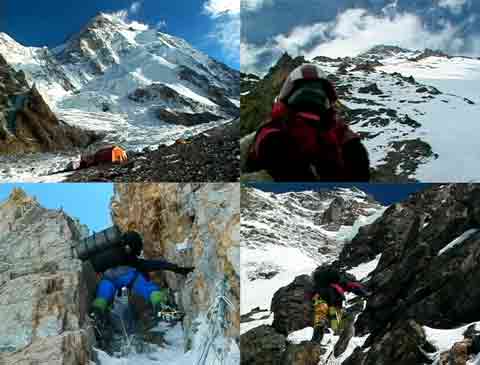
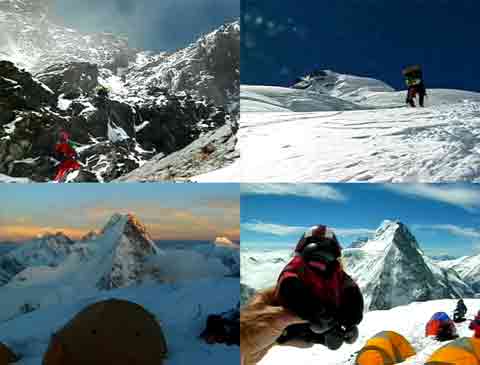
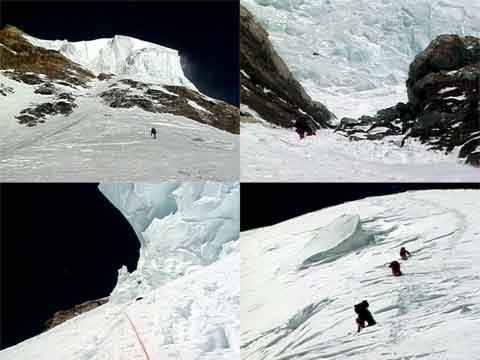
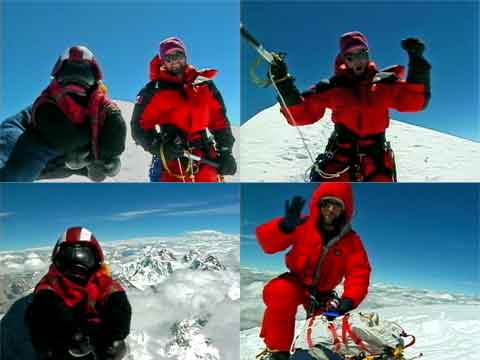

by Billy Pierson. Filmed 2000. Released 2001. 52 minutes. Billy Pierson uses a six-inch Gorilla named Murph to narrate his ascent of K2's Abruzzi Ridge as part of the International K2000 Expedition. Billy reached the K2 summit on July 30, 2000 after Chris Shaw, Andy Collins and Andy Evans.
The film follows the expedition taking a bus to Skardu on a winding narrow road in Pakistan with the frothing river below, and then continuing the drive to Askole. The porters weight loads and they trek to Paiju, wading across a river holding on to a fixed rope. Then it's on to the Baltoro Glacier with views of Trango Towers and on to Concordia and finally Base Camp where the porters are paid. Murph interviews the liaison officer, sirdar, and cook.
They start the Abruzzi ridge, slowly climbing the fixed ropes to Camp 1, and then spread eagle up House’s Chimney festooned with ropes to Camp 2. There are beautiful views of the Karakoram with the Gasherbrums and Broad Peak. They fix the black pyramid, the technical crux of the climb between 7000 and 7400m, but have to descend to Base Camp in bad weather.
They start again and climb up the snow of the shoulder, slowly panning for a magnificent sunset on Chogolisa, Broad Peak and the Gasherbrums from Camp 3 (7400m). They slowly climb to Camp 4, with yet another panorama. The next day they climb up the bottleneck past the enormous serac, and then up the summit snow slope with more panoramic views. Pierson and Murph arrive at the K2 summit and interview an emotional Andy Evans, the second Canadian K2 ascent, who is ready to descend. They get back to Camp 4 and descend to Base Camp in snowy weather. They go back up K2 to bring down the tents and gear, pack up Base Camp and trek out via Hushe.
This is an excellent home movie. The narration, background music, and camera work are very good. Murph the gorilla is funny and adds to the scenes. The film clearly shows the travel to Base Camp, the ascent route characteristics, and the weather.
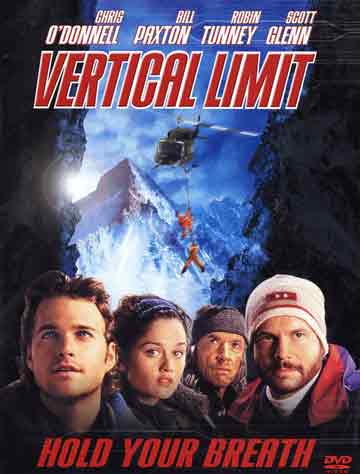
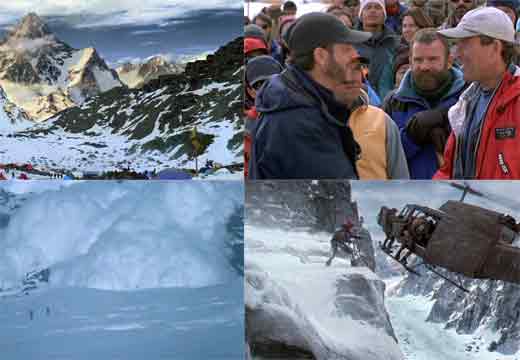
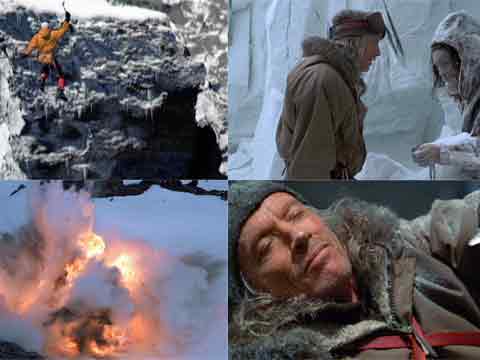

Directed by Martin Campbell. Released 2000. 124 minutes. Starring Chris O'Donnell, Bill Paxton, Robin Tunney, Scott Glenn, and a cameo appearance by mountaineer Ed Viesturs. Filmed in Pakistan, Monument Valley, and New Zealand with Mount Cook standing in for K2. The Bench brothers were based on the Burgess twins, Alan and Adrian.
Peter and Annie Garrett are an experienced brother-and-sister climbing team who have gone their separate ways after an accident claimed the life of their father. Annie has thrown herself into her climbing, claiming that only at the tops of mountains does she feel close to her father. Peter, on the other hand, has given up the sport, opting instead to pursue his love of wildlife by becoming a photographer for National Geographic. The two meet at the K2 base camp when Annie arrives with a group of climbers headed by billionaire Elliot Vaughn (Bill Paxton). As a publicity stunt for his new airline, Vaughn is determined to climb to the top of K2 so he can wave to one of his planes as it flies overhead. Leading the expedition is experienced climber Tom McLaren (Nicholas Lea), but he's really just Vaughn's puppet, bought and paid for by a $1 million check. So, when bad weather threatens and Tom argues in favour of turning back, his words go unheeded. The predictable result is a disaster (complete with an avalanche) that forces Peter to recruit an emergency rescue team and speed-climb towards K2's peak before the survivors succumb to a fatal condition called high altitude pulmonary edema. Worse still, because the survivors are trapped in an underground ice cave, Peter's group must carry canisters of unstable nitro-glycerine to blast a hole through the mountain's frozen crust.
Young climber Peter Garrett (Chris O'Donnell) risks his life to save his sister, Annie (Robin Tunney), and her summit team (Bill Paxton and Nicholas Lea) in a race against time. The team is trapped in an icy grave at 26,000 feet - a death zone above the vertical limit of endurance where the human body cannot survive for long. Every second counts as Peter enlists the help of a crew of fellow climbers, including eccentric, reclusive mountain man Montgomery Wick (Scott Glenn), to ascend the chilling might of the world's most feared peak to save her.
Extras include commentary track by director Martin Campbell and producer Lloyd Phillips; the HBO Making-Of special, Surviving the Limit (24 minutes), exploring the behind-the-scenes and preparation activities; Search and Rescue Tales that looks at the different areas of production like the sickness that climbers can face and the dangers of avalanches; and National Geographic Channel's Quest for K2 (13 minutes) takes a look at the first Americans to make it to the top of K2 in a 1978 expedition featuring interviews with people who have reached K2's summit plus older footage from previous climbs.
From a mountaineering perspective a lot of the scenes are a bit silly, but this is Hollywood, so get over it and enjoy the action. I liked the action packed, edge of your seat, high altitude scenes. The transport of nitroglycerin as a means to create tension reminds me of the 1953 thriller, Wages of Fear.
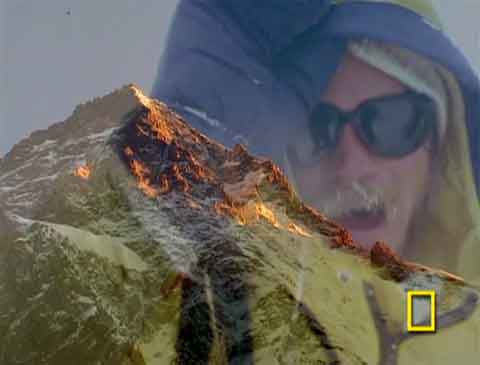
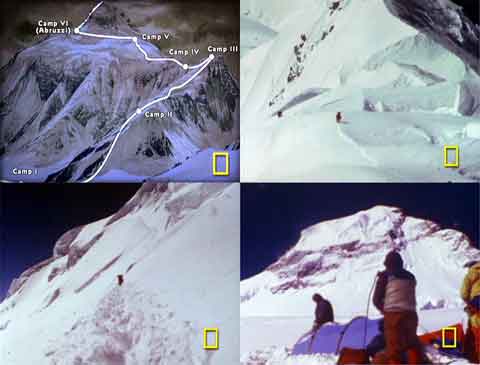
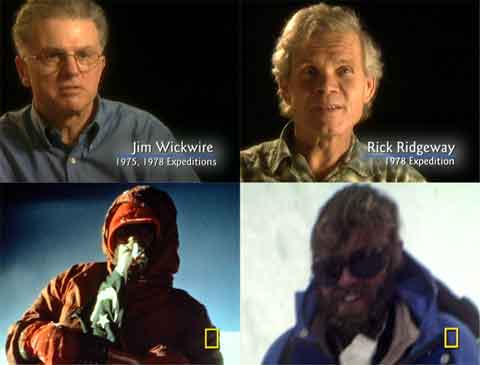

By Film Oasis. Released 2000. 13 minutes. The Vertical Limit DVD includes a K2 featurette about the first Americans to summit K2 in 1978 via the treacherous Northeast Ridge. This is a brief excerpt from the National Geographic six 30-minute TV episodes.
Jim Wickwire reached the K2 summit on September 6, 1978 with Lou Reichardt. "For me it was the culmination of this life-long dream, and I wanted to linger." And by lingering he had to suffer a solo bivouac 150m below the summit.
Rick Ridgeway reached the K2 summit on September 7, 1978 with John Roskelley. "We were on that peak above 18,000 feet for 68 days. ... Everything seemed hallucinatory. ... And we just sit there on the summit next to each other, leaning one shoulder against the other, not saying anything."
This short excerpt from the 6-part TV series features some excellent K2 scenes and footage of the 1978 American Expedition. I enjoyed seeing the interviews with Rick Ridgeway and Jim Wickwire.
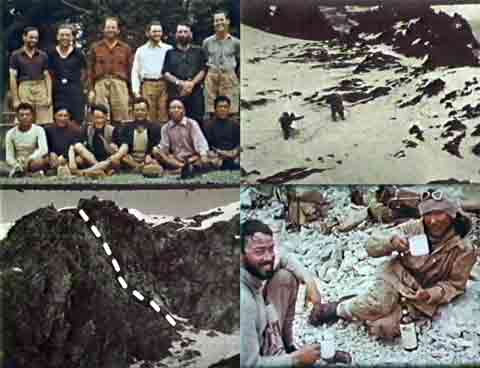
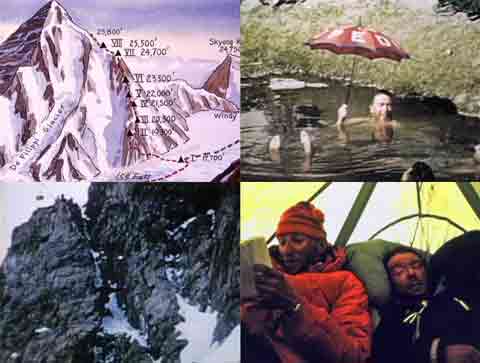
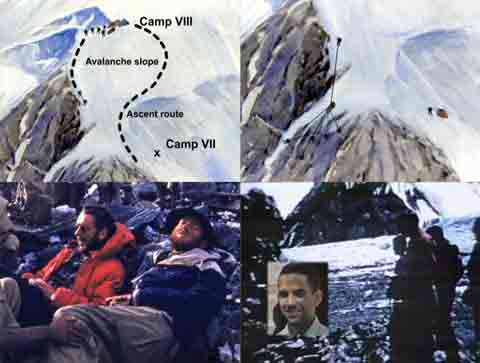

by Charles Houston. 2004. 43 minutes. This DVD, part of the book Brotherhood of The Rope by Bernadette McDonald, documents the 1938 and 1953 American K2 Expeditions. "But the rope is a bond between us, psychological as well as physical. And we always climbed roped. The bond between people whose lives are in each other's hands is an important one."
The first 9 minutes features the 1938 American Karakoram expedition. "Bob Bates and I were asked in 1938 to find a route to the summit." The film features a quick montage of scenes of Kashmir, trekking over a snow covered pass, a polo game, crossing the Indus river at Skardu, trekking to Base Camp, and climbing the Abruzzi Ridge with Bill House solving a steep rock band, now called House's Chimney. "We have found a route up the mountain ... It succeeded because we had a strong team which all worked together toward a common good."
The 1953 film starts with the flight to Skardu, crossing the Indus on a barge, scary scenes crossing rope bridges, relaxing in the hot springs at Askole, porters dancing and singing, and trekking to Base Camp. They start climbing the Abruzzi Ridge and use a pulley to drag loads up House's Chimney. The team reached Camp VIII (7800m) on August 1, but then an extended storm hits. Houston uses the team audio from August 16, 1953, photos, and illustrations from Dee Molenaar to describe the storm and subsequent desperate descent. Art Gilkey got a blood clot in his left leg as they waited out the storm.
Finally on August 10 they were able to start the descent. They wrapped Gilkey in a sleeping bag and began lowering him down towards Camp VII. Houston uses diagrams to show the descent and the positions of the team members when the accident occurred. Tony Streather: "But suddenly George was falling and he was sliding fast down this very steep ice slope. He was still tied to me ... we were all held by Pete ... and I think it was really remarkable that Pete was able to hold all five of us." Three separate ropes luckily got tangled together as the five men fell. They anchored Gilkey and went to Camp VII to set up the tents. When they went back to get Gilkey, an avalanche had ripped him from the anchors, The descent was harrowing in stormy conditions and with Houston in shock from a concussion, and Bell with frostbite in his feet and hands. They set up a memorial cairn to Gilkey near Base Camp.
I enjoyed seeing this old film footage of part of K2 history. The 1953 accident is described very well with the audio tape, photos and especially the diagrams. The colour is washed out.
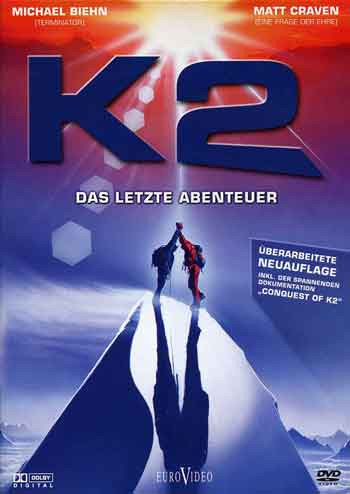
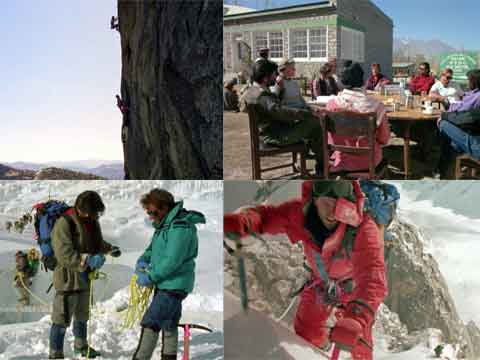
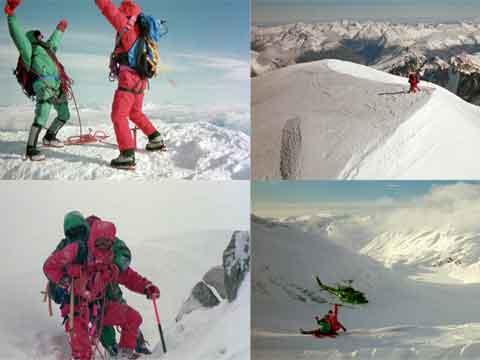

Directed by Franc Roddam. Starring Michael Biehn and Matt Craven. 1992. 106 minutes. Filmed on location in Vancouver, Whistler and Mount Waddington in British Columbia (misspelled at Colombia in the credits), and Skardu and other locations in Pakistan. This film follows two climbing friends as they climb K2. There is a 50-minute extra called The Conquest of K2.
The film is pretty true to the climbing world with snippets of: rock climbing, the young selfish climber, the family man leaving his wife and child behind, the expedition style versus alpine style climbing, avalanches, crossing a crevasse on a metal ladder, the Balti porter strikes on the way to base camp, high altitude sickness, radio communication between the climbers and base camp, ice climbing, ropes together, the bad weather, camps on the ascent, two climbers dying going to the summit, slowly and painfully reaching the summit, bivouacking in a crevasse on the descent, falling on the descent with one climber breaking his leg and his partner refusing to leave him and dragging him to rescue, the helicopter rescue.
I enjoyed the movie for being a fairly authentic climbing story - not too over the top like Vertical Limit. The trekking and climbing scenes looks fairly authentic with only a few small errors like climbing too high too fast on an 8000m peak, not wearing hats and sunglasses at all times.
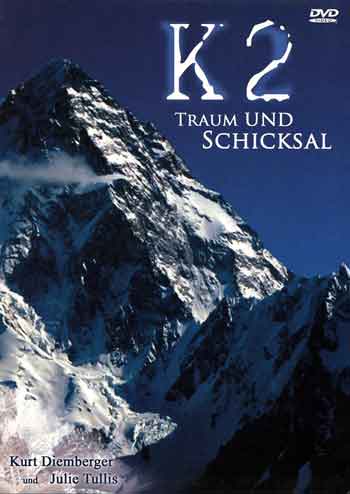
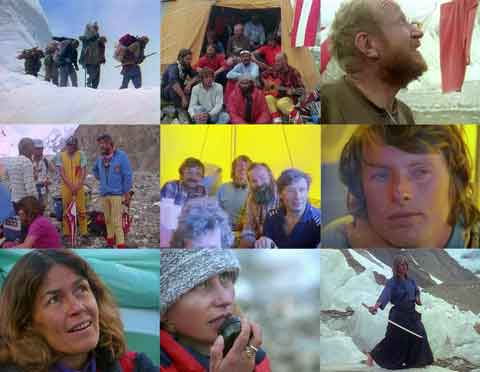
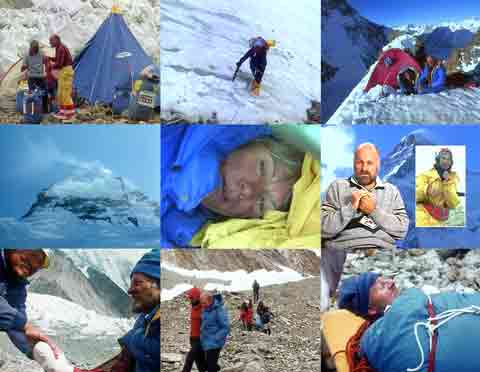

by Kurt Diemberger and Julie Tullis. Filmed on K2 in 1986. 60 minutes. This is the story of the tragic 1986 K2 season when nine expeditions converged on K2, 27 people reached the summit, but 13 were killed, seven of them after reaching the summit.
The film starts with the trek to K2 Base Camp, mainly showing the porters, making bread, trekking, and praying. We see the expeditions at base Camp, with Kurt and Julie meeting and interviewing many of the other climbers, including Al Rouse, Jim Curran, Goretta Casarotto speaking on a radio to her husband Renato Casarotto who was high on the mountain, Wanda Rutkiewicz (who became the first woman to climb K2 on June 23), the Austrian team including Willi Bauer, Alfred Imitzer, and Hannes Wieser. There is a touching scene with many climbers laughing and enjoying watching a movie.
Shot in the studio, Kurt Diemberger describes the tragic events of that season, including Willie Bauer and Kurt's own harrowing descent when a snowstorm with excessive wind and cold temperatures seven climbers, keeping them tent bound at Camp 4 for 5 days, with Julie Tullis dying in her sleep on August 7.
The film closes with Willi Bauer walking, while Kurt is carried on a stretcher to a helicopter to be flown out from base Camp.
The film quality is very good, with colour generally bright and vivid. I enjoyed the trek to Base Camp and seeing the many climbers at Base Camp, especially Julie Tullis meditating by practicing martial arts. I was disappointed in the brief actual climbing scenes with nothing high on the mountain.
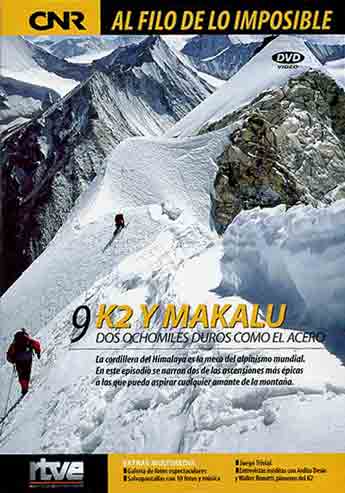
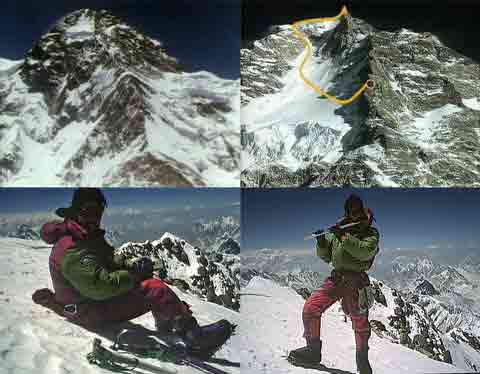
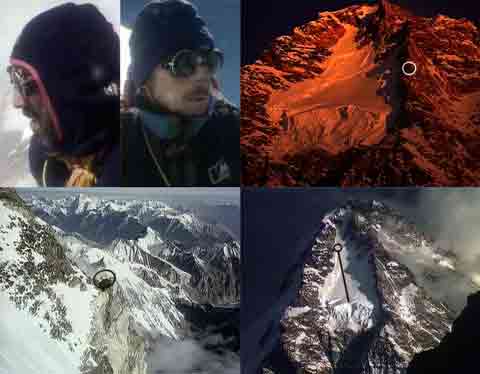

by Sebastian Alvaro. Al Filo De Lo Imposible, Spanish TV 1995. 36 minutes. Filmed in 1994. This film documents the 1994 Spanish K2 North Ridge Expedition. It features studio interviews with Doctor Ricardo Arregui, Juan Jose Sansebastian, Inaki Ochoa, and Ramon Portilla. This DVD also contains Makalu (filmed 2002, 53 minutes). Extras include interviews with Ardito Desio (14 minutes) and Walter Bonatti (17 minutes).
The film opens with doctors working on the severe frostbite of Spanish climber Juanjo Sansebastian. It then switches to the trek to K2 North Base Camp, using horse and camels. crossing rivers, and trekking under K2's North Face, and then setting up high camps. When an old fixed rope broke, Inaki Ochoa suffered an 80m fall, breaking his right arm and three ribs, and suffering nose injuries. He then had to be helped to painfully descend to base camp.
The first team climbed up the North Ridge, and on July 30, 1994 Jose Carlos Tamayo and Sebastian de la Cruz reached the K2 summit via the North Ridge. The final ascent and summit shots are from photos, including Jose Carlos playing the flute on the summit.
The next summit team then leaves base camp for their attempt, and climb up to camp 3, camp 4 and on August 4, 1994 Juan Ignacio (Atxo) Apellaniz and Juan Jose (Juanjo) Sansebastian also reached the K2 summit via the North Ridge. They had to bivouac above 8000m on the descent. In the morning, San Sebastian was swept away by an avalanche, but miraculously came to a stop 400m just above the top of the hanging glacier. He made it to camp 4, but then had to go back to help his exhausted partner Apellaniz, who started showing symptoms of altitude sickness. Despite the help he received from below, after seven agonizing days, Apellanitz died at camp II on August 10, where the whole team was delayed by a blizzard. San Sebastian returned home, but he paid for his adventure on K2 and his bravery with the amputation of seven fingers.
The video quality is good, not great. There really isn't much climbing footage. The film is really the interviews with the participants telling the dramatic story.
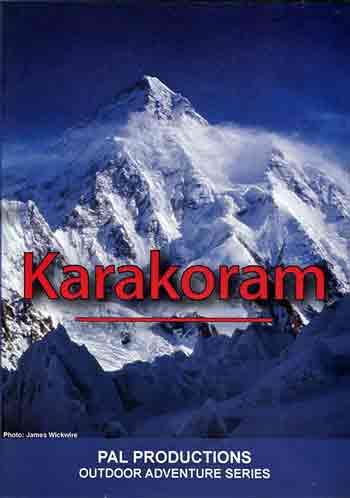
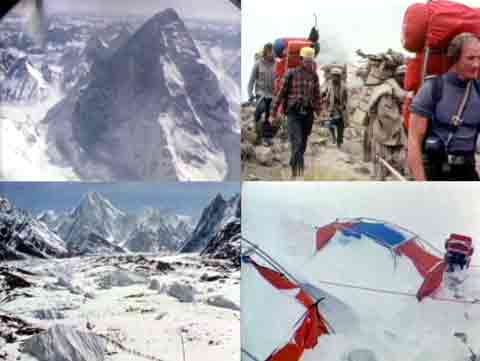
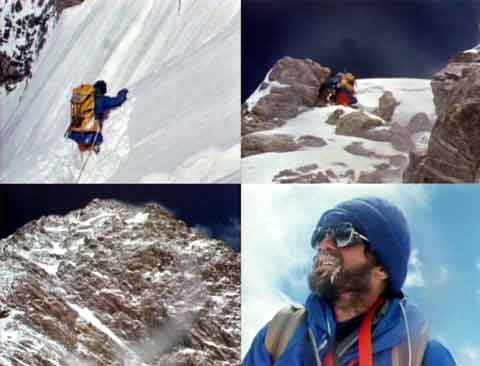

by Steve Marts. Filmed 1975. Release 1976. 47 minutes. This is the story of the 1975 American K2 Expedition attempting the unclimbed Northwest Ridge. The team was led by Jim Whittaker and included his twin brother Lou, Jim Wickwire, and famed photographer Galen Rowell.
The films shows hectic street scenes in Rawalpindi where the team waited two weeks for good flying weather. They fly past Nanga Parbat and get an aerial reconnaissance of K2 before landing at Skardu. The porters are selected and the trek to base Camp begins. We get a glimpse into the Balti people, their villages and their way of life, while the porters and expedition members trek along the Braldu river and onto the Baltoro Glacier. The expedition doctor Rob Schaller treats both porters and the villagers along the way. There are so many porters that when they stop for the night, the expedition looks like a village. The expedition has trouble with porters, but finally reaches Base Camp on the Savoia Glacier, three weeks behind schedule.
They pay off the remaining porters, set up their Base Camp tents, and unpack and repack the loads. They carry loads to Camp 1 and Camp 2, and climb up steep snow above Camp 2. They have to descend to Camp 2 when a 5-day storm blows in. After the storm, they descend to Base Camp and again climb above Camp 2 reaching the ridge at 21,500 feet. Towering above them was the K2 summit, but to reach it they still had to negotiate the pinnacles. They were hit by another 5-day storm and they descended, carrying down a sick high altitude porter using a stretcher. The return crossing a river on a scary rope bridge and pass villages now harvesting their crops.
The climbing story is fairly straightforward with good mountain views. This DVD is more about the Pakistani porters, villages and people, then about the climb itself. The video quality is good, with the colour a bit faded and washed out. The film does not show any of the personal conflicts that Rowell highlights in his book, In The Throne Room Of The Mountain Gods.